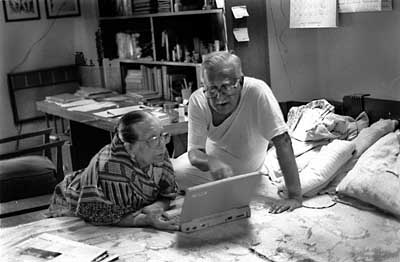![]()
letter-to-the-french-government.docStop Press: Ten crates containing rare archaeological treasures of Bangladesh have been bundled out of the national museum and are said to be bound for Guimet Museum in Paris, via flight AF 6731 (dep: 1205 Saturday 1st Dec 2007). Preparations had been made to secretly remove the items through a shipment order by the French Embassy made to Homebound Packers and Shippers. Trucks and forklift arrive secretly in museum in early hours of morning. But the news leaked and media professionals and protesters gathered outside the museum. Under heavy police presence Homebound vehicles (Dhaka Metro Umo 11-0814, pho 11 3634, U 14 0187) and fork lift trucks all bearing “Save The Children and USAID Cyclone Sidr Emergency Relief ” signs were used to remove the priceless items. Predictably, and as in the case of all previous authoritarian governments, while the story was the lead news in all major newspapers and independent television channels. BTV the state run television channel which is the only terrestrial channel in Bangladesh, failed to report the incident altogether.
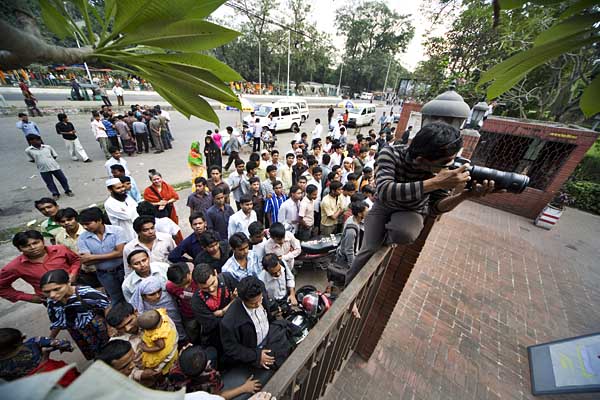
Protesters and media professionals watching as crates get loaded onto Homebound trucks. ? Shahidul Alam/Drik/Majorityworld
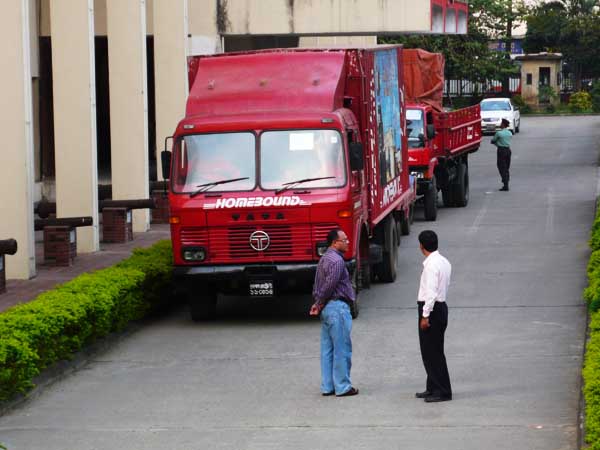
Homebound trucks preparing to leave National Museum. ? Shahidul Alam/Drik/Majorityworld
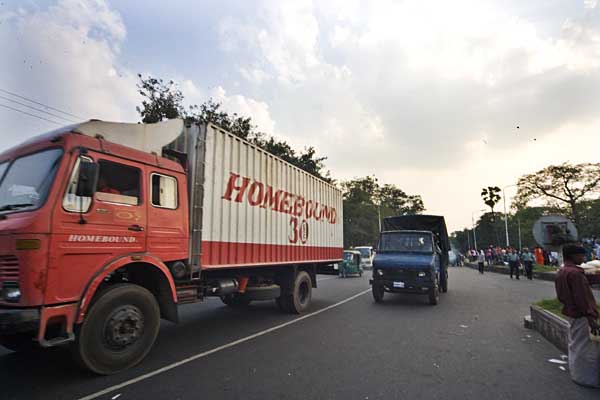
Trucks being escorted out of National Museum by police. ? Shahidul Alam/Drik/Majorityworld
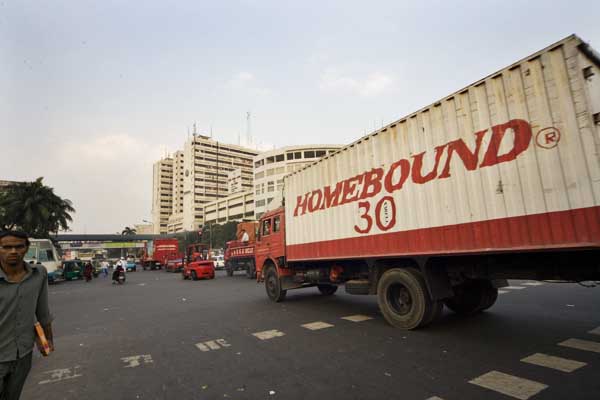
Homebound convoy heading to airport. ? Shahidul Alam/Drik/Majorityworld
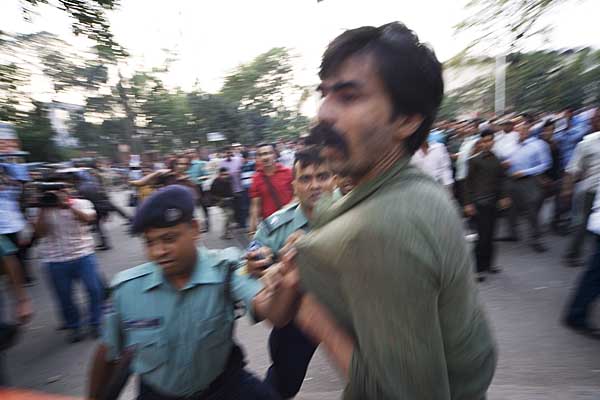
Police arrest Shekhar Shaswata. ? Shahidul Alam/Drik/Majorityworld
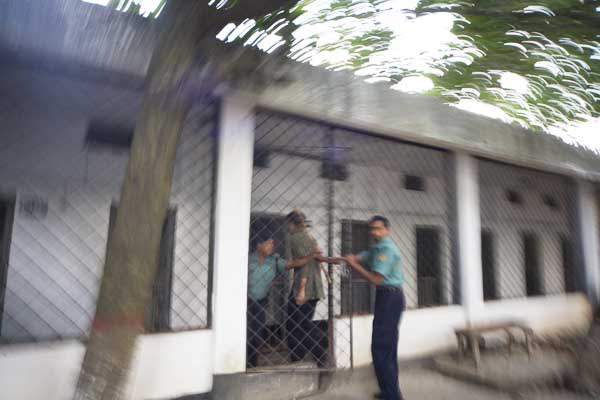
Shekhar being taken into custody. ? Shahidul Alam/Drik/Majorityworld
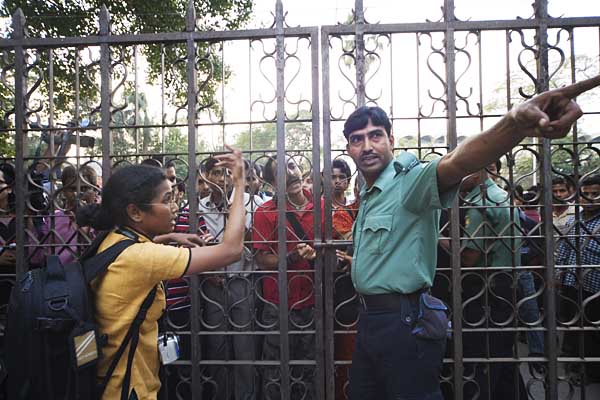
Media professionals demanding to be let in. ? Shahidul Alam/Drik/Majorityworld
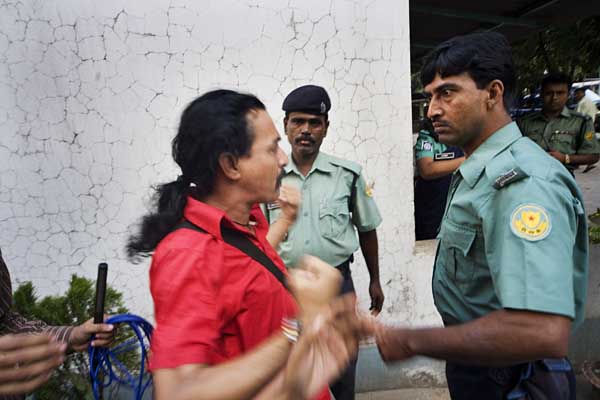
Further clashes with police. ? Shahidul Alam/Drik/Majorityworld
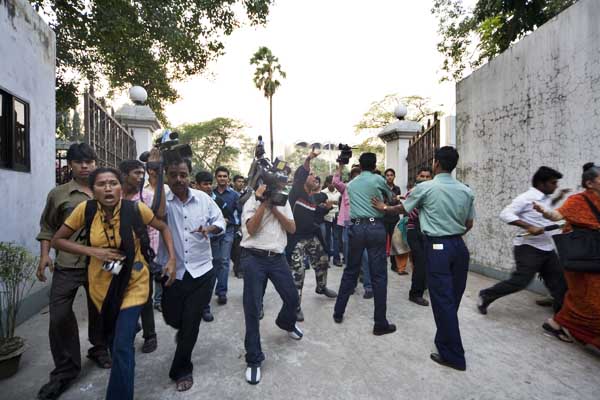
Media storm into Shahbagh police station. ? Shahidul Alam/Drik/Majorityworld
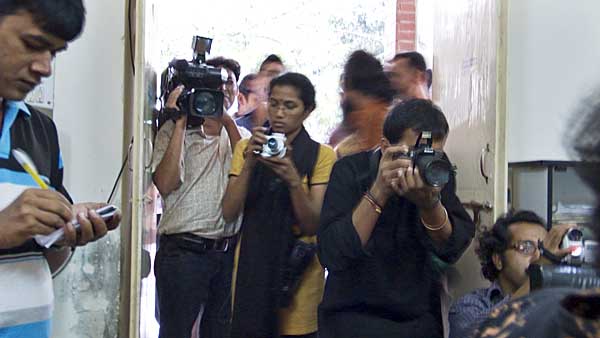
Media in officer Morshed’s office. Morshed claims he knew nothing of what was going on all day across the road. ? Shahidul Alam/Drik/Majorityworld
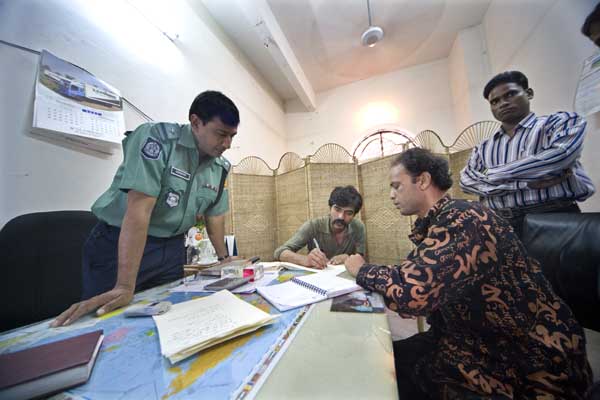
Shekhar being released upon signed undertaking by those demanding his release. ? Shahidul Alam/Drik/Majorityworld
Protesters clashed with police. Shekhar Shashwata was arrested, and some media professionals roughed up. Eventually protesters were able to get Shekhar released. Police officer Morshed who made the arrest, claimed he “knew nothing about what was happening across the road.”
The lack of transparency surrounding the exhibition has led to huge controversies where leading citizens have demanded that the government and the French Museum allow experts to inspect the items being taken away. Past allegations of art objects having been taken to France and never returned have increased the suspicion.
While the government has appointed a committee to investigate the matter, in an unprecedented move, government and French Embassy officials have, without informing either the committee or the media, taken the items out of the museum in what resembled a police protected museum robbery.
Protesters are asking international media to disseminate the news, and prevent the artefacts from being taken away in this manner. Bangladesh is under emergency rule where protests and gatherings of any form are illegal, and police have wide ranging powers. After a recent unrest at the universities arrest warrants were issued against 8,300 largely unnamed people. Teachers, students and university employees arrested after the event are yet to be released. There have been accusations of torture in custody.
———-
Earlier on in the day:
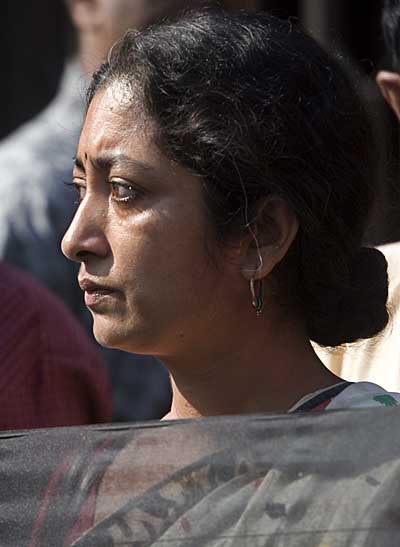
Above: Tearful protester outside museum at 10:15 AM 30th November 2007. Below: Homebound truck with Cyclone Relief sign outside museum.
? Shahidul Alam/Drik/Majorityworld
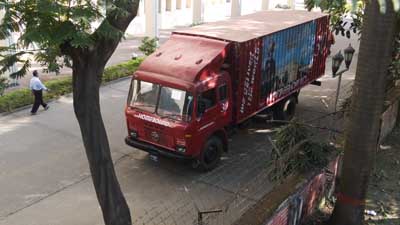
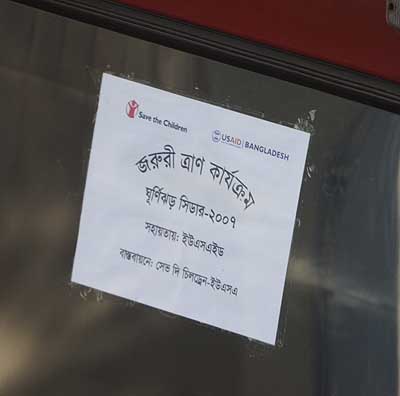
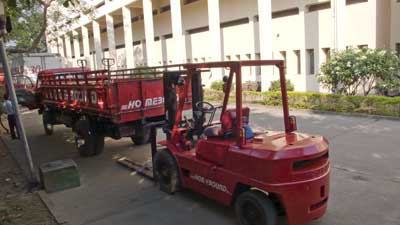 Forklift on standby
Forklift on standby
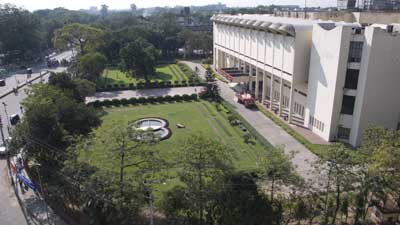 Forklift in front of Museum
Forklift in front of Museum
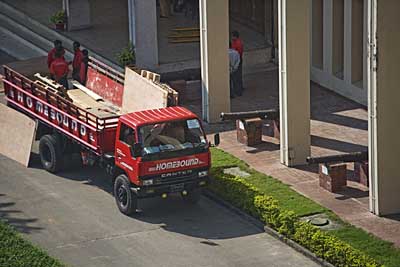 Homebound in line of fire
Homebound in line of fire
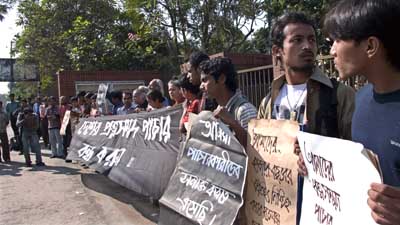 Protesters outside museum
Protesters outside museum
Video of protests. ? Rabeya Sarkar Rima/DrikAV
The background to the story by Anisur Rahman
Letter to the French Government by prominent citizens
1st Video Clip of Protest Press Conference. ? Naeem Mohaiemen
2nd Video Clip of Protest Press Conference. ? Naeem Mohaiemen
———————————————————
The Price of Priceless Objects by Shahidul Alam
This was breaking news. Shishir Bhattacharjee, Nisar Ahmed and Rahnuma were racing against the clock. The pukur churi (daylight robbery, lit: pond stealing) had to be stopped. Bangladesh is awash with conspiracy theories and I needed to be convinced that something irregular was really taking place. A major exhibition of Bangladeshi heritage in a well-known western museum seemed a good thing. I wanted hard facts. Facts emerged, and eventually tumbled out.
The issue in question was a proposed exhibition at the Mus?e National des Arts Asiatiques – Guimet, in Paris, where some of the most prized archaeological objects collected from the five major museums would be on display in an exhibition announced on the Museum website as “Masterpieces of the Ganges delta. Collections from the Bangladesh Museums.” The only suggestion that things might not be going entirely as planned came from the notice “dates to be confirmed.” The France Guide still lists the original dates: 24/10/2007 to 03/05/2008.
Doubts had been raised about the transparency of the process through which the exhibition had been arranged. With leading national experts calling for a stay order and the court requiring the government to demonstrate that due process had been maintained,
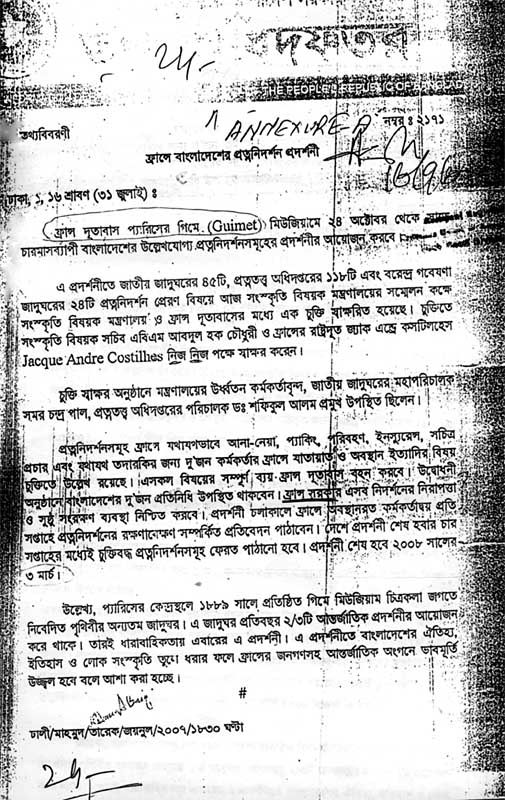
things were getting murky. A hastily called press conference by the French Embassy landed them in further trouble. The Ambassador was promptly withdrawn. Unconnected some say, but unusual in a country where the departure of western ambassadors is generally accompanied by considerable fanfare.
“Some Bangladeshis who want to improve the image of Bangladesh abroad have been supporting the exhibition”, the new ambassador stressed. The suggestion that the Bangladeshi experts who had questioned the intentions of this prestigious museum and the French government itself, and even had the audacity to suggest that the French might possibly have intentions not entirely in keeping with Bangladeshi interests, were unpatriotic, was perhaps unintentional.
Not a hair on Sita’s head was singed as she had walked through the flames. But she had been doubted, and she felt only the test of fire could prove her innocence and her loyalty. Who is loyal to Bangladesh is now the question. Protagonists of the proposed exhibition at Guimet promptly dismissed the ones who demanded transparency, as Talibans and enemies of the state. My beard didn’t help.
The fact that these very experts had over the years been the mainstay of collecting, creating and nurturing these collections, didn’t appear to affect the French argument. Given Kwame Opoku’s recent statement “Mus?e Guimet in Paris which incidentally also holds thousands of stolen/illegal objects from China and the rest of Asia,” one would have expected the French to be more concerned with damage control.
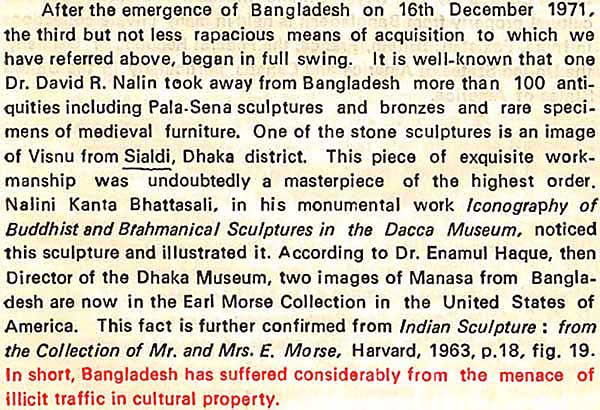
Extract from “The Museums in Bangladesh” by Firoz Mahmud and Habibur Rahman from the chapter initiated by the “Ad Hoc Committee on the Return and Restitution of Cultural Property to its Countries of Origin” set up by the International Council of Museums ICOM. Page 487.

Extract from list of organisations and locations where stolen Bangladeshi cultural property have been illegally taken. Page 488
Or was this an attempt to gain what they could before the cat got out of the bag? Els Van Der Plas, the director of the Prince Claus Fund in the Netherlands, held Guimet in high regard and had respect for the director. June Rollinson of the British Council in Dhaka, also spoke highly of the Guimet. Mark Haworth-Booth, former senior curator of the Victoria and Albert Museum in London, was an old friend and had been a guest teacher at Pathshala. He fully supported museums lending work to each other but felt a shared copyright of the photographs (the contract gave Bangladesh no rights over the images of the artefacts) would have been the normal practice.
However it was Mark’s comment “I do not think that professionally-run museums would lend an object if it had no accession number” that got me going. The appendix listing the items, obtained by court order, was a farce. The number of items varied in different reports. We managed to obtain the French internal listing which had 20 more items than the Bangladeshi list. These had been obtained in a joint excavation (France and Bangladesh) in Mahasthangar, and were all marked ‘reserved’. Items had been clumped together without individual listing (e.g. ’93 punch-marked coins’). Insurance value was sometimes missing. The basic documentation of a normal museum inventory, like period, condition and markings were missing. A large number of items had no accession numbers. And this was a listing of the most precious items belonging to Bangladesh, many of which Bangladeshis themselves had never had the opportunity of seeing! Not even the nation’s leading scholars, researchers historians or archaeologists. Certainly, it was the Bangladeshi side that should have provided these details, but with UNESCO stressing ‘due diligence’ on the part of the borrower, to accept such a precious consignment on the basis of such flimsy documentation, was fishy. More importantly, there was no way in which even the most diligent officials could verify that the objects lent, were indeed what had been returned.

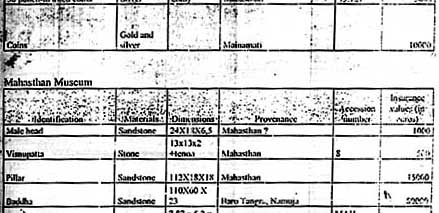
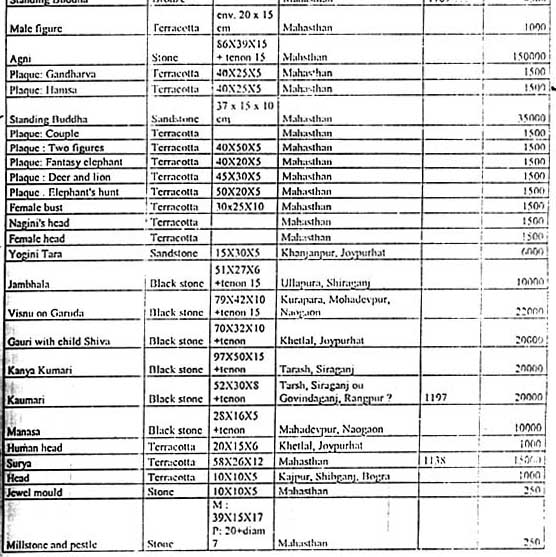

This was what the French press release had insisted was ‘complete documentation’.
When Jos van Beurden sent me his soon to be published article “Diplomats and smuggling of art” providing extensive and well documented instances of how majority world countries had their art objects stolen by wealthier ones via diplomats, it appeared as if it is the image of France and not of Bangladesh that needs rescuing.
With some juggling of schedules, I was able to combine a trip to Paris to show a newly made film, with the possibility of a trip to the Guimet.
Mus?e du quai Branly, the museum inviting me, was also on the ‘wanted’ list put together by Opoku and others. I needed no further convincing. I was off to Paris.
Quai Branly had sent a car to pick me up from Charles de Gaulle airport, and it was with considerable curiosity that I asked the driver what he thought of the Guimet Museum. Xavier had never heard of the place. I must have been unlucky with my driver, for Michel Philpott of Le Monde du, who had invited me, did indeed know the Guimet. It was perhaps not amongst the finest in the world, but still an important museum. It was also within walking distance.
The following morning, my Armenian photographer friend Ruben and I decided to pay the Guimet a visit. I had my HDV video camera with me. I had done a few other things in preparation too, like writing to the press officer Helene Lefevre, asking for an appointment. She did respond to my mail, but no appointment had been granted. I had been concerned that the Bangladeshi government had no rights over the photographs taken by the French photographer, but a mail to him also failed to elicit a reply. So Ruben and I were taking our chances. With my own work having been shown at the Centre Georges Pompidou fifteen years ago, I thought I had the credentials as an artist. I also had my press pass.
Crossing the Seine on a sunny Paris day, looking back at the Eiffel Tower, walking through the manicured pathways with Parisians striding by in their haute couture, I could picture Doisneau photographing the famous kiss.
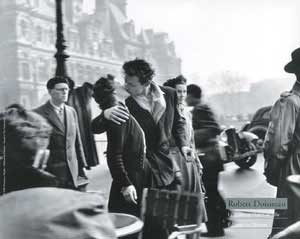
The Kiss. ? Robert Doisneau/Magnum
Finding the museum in the busy Paris map was not easy. Tucked away in the edge of a roundabout in Avenue D’Iena, was our famous Mus?e Guimet. Two homeless people had camped outside on the footpath, and children were having lunch on the short staircase. This represented the reality in all our countries but is distant from the image the establishment generally tries to provide.
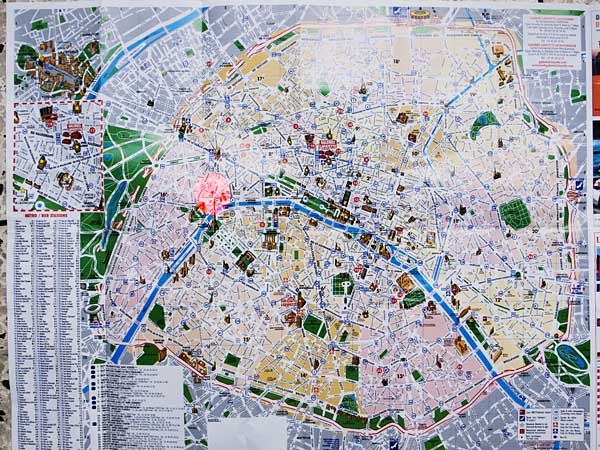
Map of Paris. Guimet Museum shown as small dot in centre of red circle.
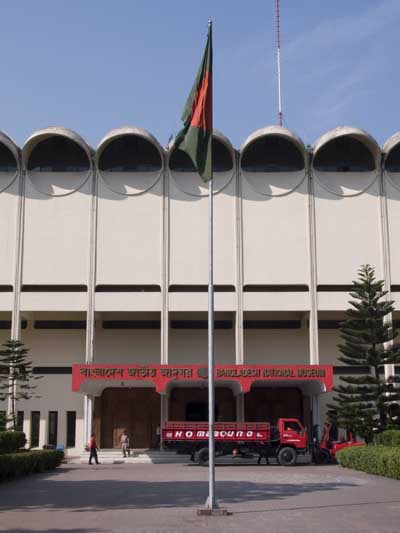

Left: Homebound truck loading outside Bangladesh National Museum 11:15 AM 30th November 2007. Right: Homeless people outside Guimet Museum. Paris. France. 31st October 2007. ? Shahidul Alam/Drik/Majorityworld
I felt at home as I walked through the small entrance. This was far less pretentious than our own national museum. The informality of the place was comforting. The elderly gentleman beside us as we stood at reception overheard me asking about the Bangladeshi exhibition. Speaking with an American accent he remarked on what a fine show it would be. “It was taking time, but it would definitely be there.”
I was in journalist mode, and having discovered that he was Ambassador Dean and a board member of Guimet, gently led him on to the sort of work the museum was known for. He pointed out that the museum had just restored the head of a Cambodian statue to its body after 500 years. “Where was this statue?” I asked in as innocent a tone as I could muster. “Right here in this museum” was the proud board member’s reply. The head that was France’s gain, was presumably Cambodia’s loss.
I was lucky. Both the director of Guimet Jean-Francois Jarriage and the curator of the show Vincent Lefevre, were available that day, and didn’t appear to have any appointments at that time. I handed over my card, and spoke to Anna the director’s secretary, over the phone. She hadn’t seen my card then, but when I explained over the phone that I was from Bangladesh, I could sense a chill. Suddenly everyone clammed up. Neither the director nor the curator was able to see me, and no one in the museum would make any comment. Perhaps it was years of colonialism that had shaped our behaviour, or our rustic mannerisms of hospitality. I couldn’t help wondering how a visiting journalist who had arrived at the doorstep of any of our museums, would have been drowned with cups of sweet tea laced with condensed milk by the time the director had come over.
It was only a month ago when I had walked through the national museum at Siem Reap, aghast at the rows of ancient Cambodian statues whose heads were missing. One wonders where the heads have landed up. Ambassador Dean’s quest for restoration might just result in Guimet’s acquisition of the remainder of the bodies.
“Masterpieces of the Ganges delta.” France’s gain, Bangladesh’s loss?
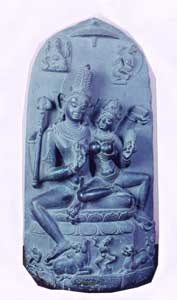
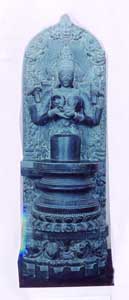
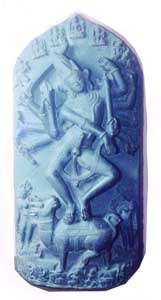
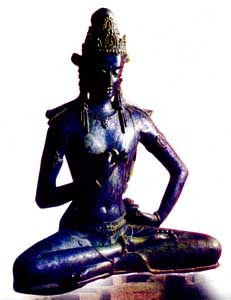
Some of the rare sculptures being taken to Guimet Museum
Article by Kwame Opoku
Category: Bangladesh
Just Hand Me A Biri
![]()
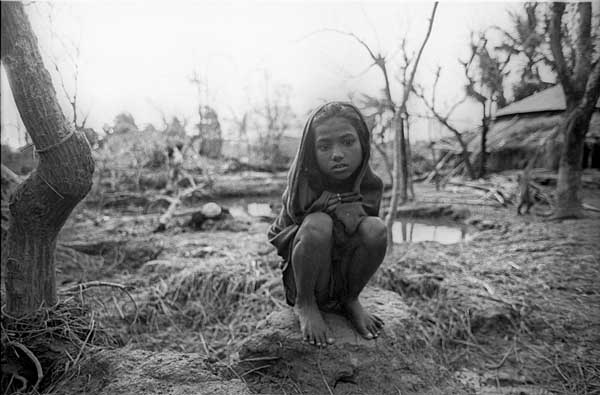
Orphaned girl by the remains of what was her home. Anwara. Bangladesh. 1991. ? Shahidul Alam/Drik/Majority World
“The dark cyclone shelter was packed with people, mostly women and children, some crying, some screaming. It was chaos. And then there was the loud knock. We struggled to open the door against the wind, The whole night sky tried to get in through the small gap we had made. The man pushed his way in as we struggled to lock the door again. He was a strong burly man, but he was shaking. “Give me a biri (hand rolled cigarette)” he said. I got angry. “Can’t you see what is happening here? What state people are in? And you want a biri?” He wasn’t harsh, but his stare was cold. “Agaro jon re puita aisi. Biri de.” (I’ve buried eleven. Just hand me a biri).”
This had been 1991. We had crossed into Hatia, and the ride across the choppy sea had left us all rattled. Slowly people spoke of their experiences on the night of the 29th April 1991, when the sea had become a wave.
This time I was stranded in Kathmandu when I received the news from Rahnuma. She was dreading the worst. The ticker tape on CNN said the storm was 100 kilometres from Dhaka, when I finally went to sleep in the early hours of the morning. This was the time of Internet and mobile phones, but the Net was down and the network was too congested to get calls through. Irfan managed to send a text the next day asking me to charge my mobile. Dhaka had no electricity.
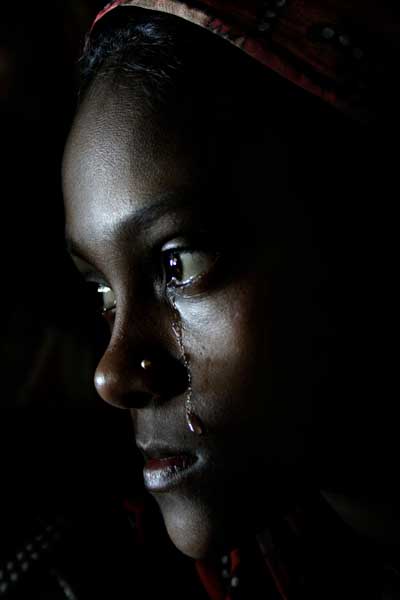
Cyclone SIDR. Dublar Char, Bagerhat, Bangladesh. November 26 2007. ? Asad/DrikNews
Joshim was waiting as usual at the airport. At least there was electricity there. Some of the street lamps were lit. I managed to make it home in the early hours of the morning. Most of Dhaka was then in darkness. We did have electricity in the flat, but it soon went. Ragni and Nunni (two of our many children) were both fast asleep. Ragni went off this morning to an FK meeting, an exchange partnership we are involved in. The Net is up again, at least partially. Nipun is designing the majority world flyer. Life goes on. We don’t yet know the extent of the damage, but the figures are undoubtedly high. We are fine. Many others sadly are not.
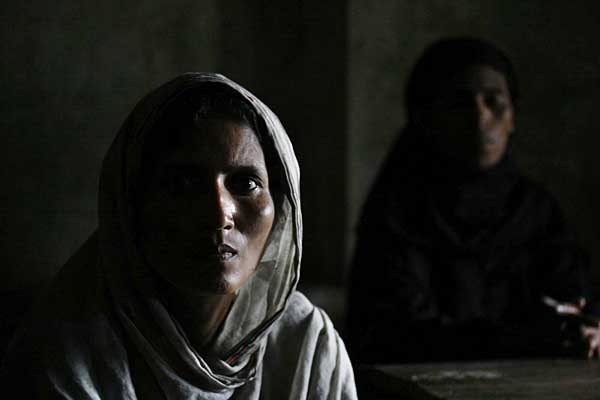
Women in a cyclone shelter centre at Coxbazar, Bangladesh. Cyclone SIDR. November 16 2007. ? Munir uz Zaman/DrikNews
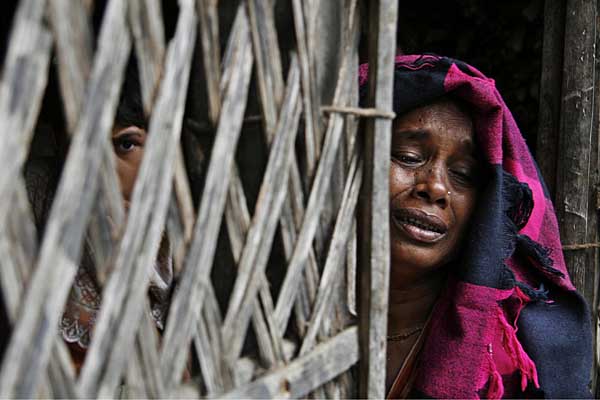
A woman weeps for her lost relatives. Cyclone SIDR. Khulna. Bangladesh. 17th November 2007. ? Tanvir Ahmed/DrikNews
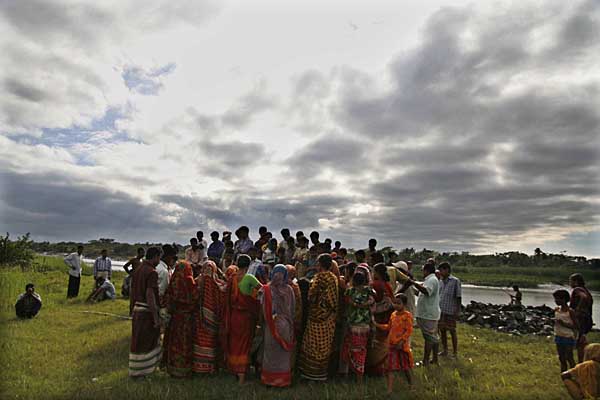
Relatives and neighbours bury their dead by the Rupsha River. Cyclone SIDR. Khulna. Bangladesh. 17th November 2007. ? Tanvir Ahmed/DrikNews
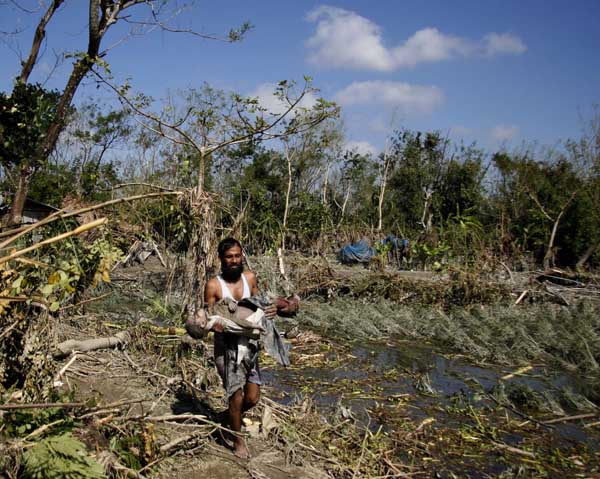
A man carries his grandchild?s dead body from debris of the house. Cyclone SIDR. Shoronkhola, Bagerhat, Bangladesh. November 19 2007. ? Tanvir Ahmed/DrikNews
My bike was at Drik, so I took a rickshaw to the office. The rickshawalla’s name was Shah Alam. Our similar names added to our camaraderie. He was from Bhola. They had lost twelve. “But I have a mobile” he said sheepishly. Almost apologising for this perceived opulence. “At least this way I can talk to my parents.”
Abir and Munir are already out there. Jessica is preparing to leave for Patuakhali. In 1991, I had rushed back from Feni and managed to bluff my way into a military helicopter to do a story with Barbara Crossette for the New York Times. Sending the picture through the old fax transmitter in the T&T office took hours. With most connections down, we had struggled to get the picture through. And then I was out again. It was only when I met James Nachtwey in Chittagong that I found out that my picture had made the front page of the Herald Tribune. Now as I sit behind a computer screen typing text and booking tomorrow’s flight to Sri Lanka, other photographers are headed for the coastline.
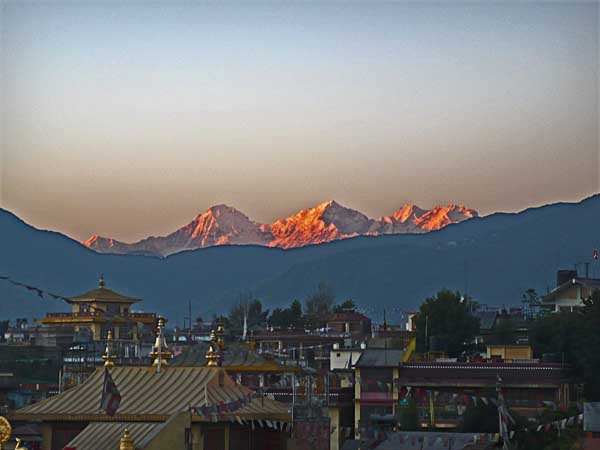
Sunset on the outskirts of Kathmandu. Nepal. 16th November 2007. ? Shahidul Alam/Drik/Majority World
Last night as we waited for yet another hugely delayed GMG flight, Nayantara took Tutul and I to catch the last glimpse of sunlight in the mountains outside Kathmandu. The chanting of the priests, and the gentle bells from the stupa below made Dhaka seem far away. We even stopped to give an interview on CJMC’s new FM station. Back home Bazlu bhai and his team have been pushing for permission for community radio for years. A much needed tool in times of crisis. The airwaves here have been reserved for propaganda. A once outspoken media sings the glory of the military and the untiring efforts of the government. Some with reluctance.
Saving people’s lives seems a far lesser priority.
——
Find link for interview on Radio France Internationale (streaming)
Afsan Chowdhury’s interview on climate change in Bangladesh
or download file: sa-2nd-clip-from-french-radio-on-cyclone.mp3
article-on-natures-fury.pdf (from the Book: Communicating Disasters, by TVEAP and UNDP)
Bangladeshi photographers win yet again!
![]()
G.M.B.Akash a student from Pathshala’s first batch wins first prize for his photo titled “Passengers without Ticket” in the prestigious Gordon Parks Photography Competition 2007. More work by Akash can be seen at www.majorityworld.com and www.gmb-akash.com.

Other winners include “A woman standing by her paraplegic husband” by Lisa Wiltse (2nd place)

“Touch of protection” by Olivier Asselin (3rd place)
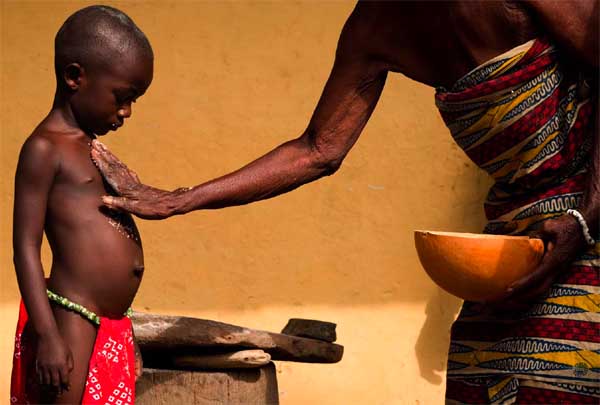
“Loss” by Chris Zuppa (honorable mention)

Mom and me by Kenny Felt (honorable mention)
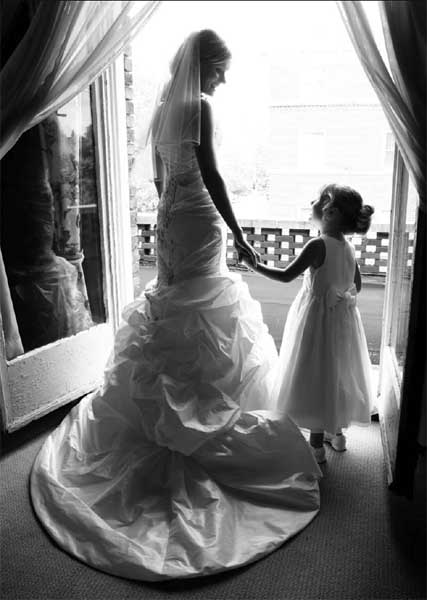
and “New Citizen” by Jim Gehrz (honorable mention)

More news on the contest available soon from www.gordonparkscenter.org The video of Chobi Mela IV can be seen at: http://link.brightcove.com/services/link/bcpid1213900621 The video “In Search of the Shade of the Banyan Tree” can be seen at: http://www.brightcove.tv/title.jsp?title=1237905984 Thanks to Oliver and Angilee and UCLA International Institute for uploading the video, Asfia for the Banyan Tree song and to the large number of people who helped in the production of the videos.
Bangladeshi photographers have consistently shone internationally. Yet photography remains neglected by the Bangladeshi government. A bill passed in parliament in 1989, to open a department of photography in “Shilpakala Academy” the academy of fine and performing arts, has yet not been implemented. Even “Charukala Institute” the department of fine arts, lacks a photography course. Yet Dhaka is rapidly becoming one of the major capitals of photography and Chobi Mela, the festival of photography held in Dhaka is one of the major events in the Asian media calendar. It has often been the case that artists have only been recognised in our own soil once they have received international acclaim. Sadly, even outstanding international perfomance in the field of photography, does not appear to have woken up the fossils in the Bangladesh secretariat.
Bangladesh Now
![]()
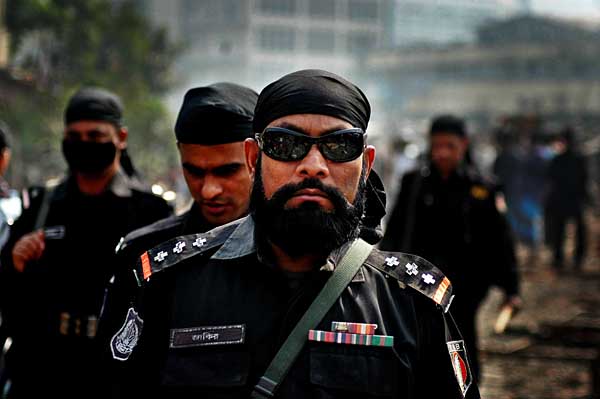
The Rapid Action Battalion (RAB) were setup as a crack team to support law enforcement. Numerous accusations of extra judicial killings have been attributed to RAB, usually followed by a government press release about people having died in a ‘crossfire’. ? Munem Wasif/DrikNews
Dark glasses, black bandana, arrogance in his face. ‘The Protector’ strides with purpose. A new word enters our lexicon. You can now ‘crossfire’ a person. No questions asked.
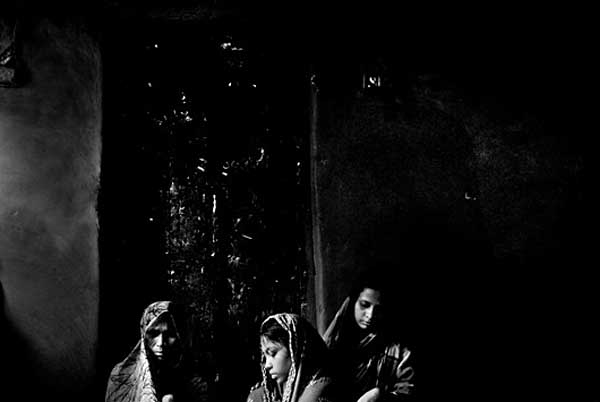
Hanif, a mill worker, was shot dead by the police during a protest rally organised by the workers. Two hundred workers were injured. Crescent jute mill, Khalishpur, Khulna, 11 September 2006. ? Munem Wasif/DrikNews
She mourns in silence. Her man, a worker in a mill, is no more. His crime? Demanding payment for his labour.
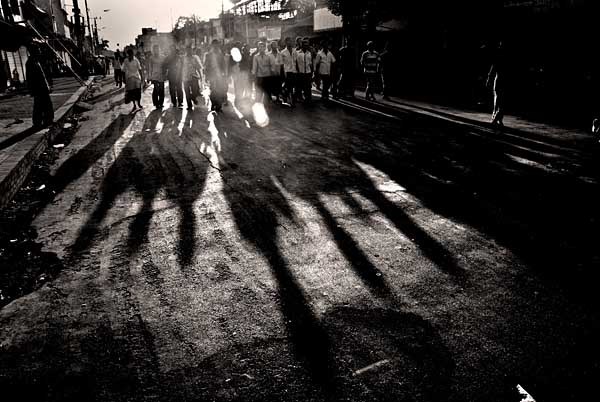
Workers protest on the streets of Khalishpur, even during emergency. ? Munem Wasif/DrikNews
A child screams.
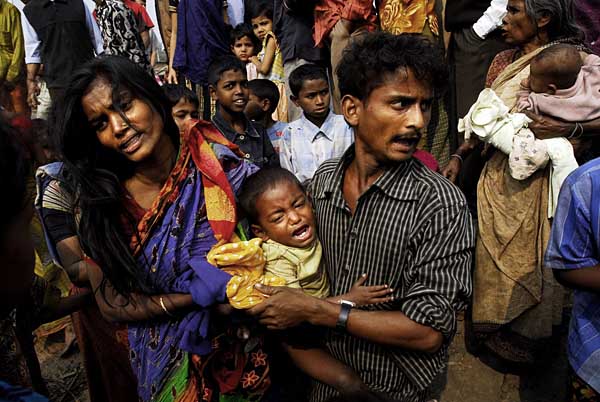
Soon after coming to power, the caretaker government ordered all illegal constructions and slums be torn down. Those affected do not know where to find shelter since laws and their interpretations are mostly anti-poor. Dhaka Bangladesh. 24 January 2007. ? Munem Wasif/DrikNews
Evicted from a slum that offered little, his parents in search for even less.
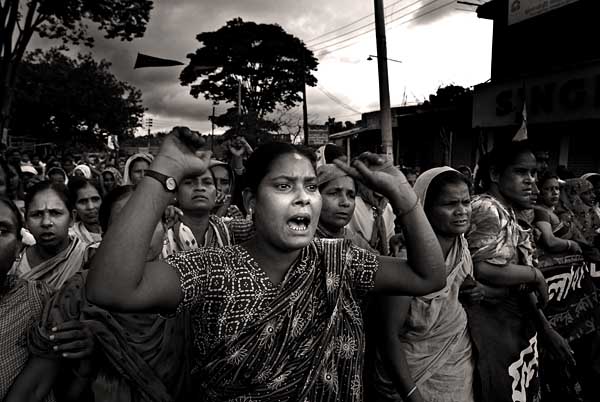
Muslim and Adivasi women unite in their fight against multinationals. Phulbari Bangladesh. 30 September 2006. ? Munem Wasif/DrikNews
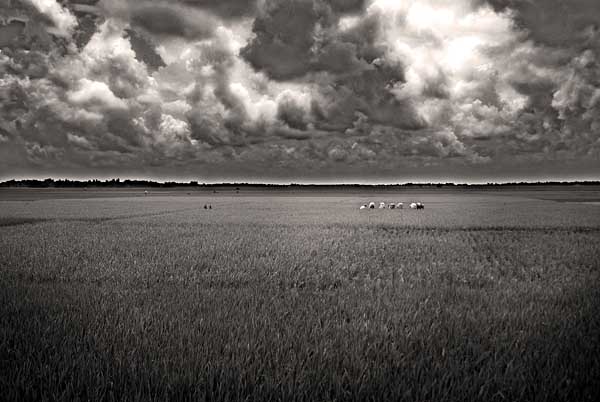
These green fields will disappear if coal mining starts. Phulbari Bangladesh. ? Munem Wasif/DrikNews
Angry women protest the illegal hand-over of their land to multinationals.
————————————-
Choles Ritchil killed in custody
————————————-
And the missing photograph. The one we cannot show. The one of the Adivashi leader tortured and killed in custody. He too had the temerity to resist government takeover of his ancestral land.
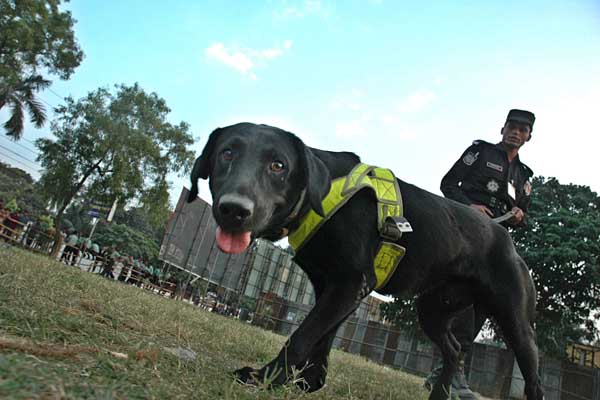
A member of Rapid Action Battalion (RAB, Bangladesh’s elite security force), checks the grounds with a dog squad to ensure security of the 14 party led Awami League’s grand rally the next day. Paltan, Dhaka Bangladesh. December 17 2006.
? Munir uz Zaman/DrikNews
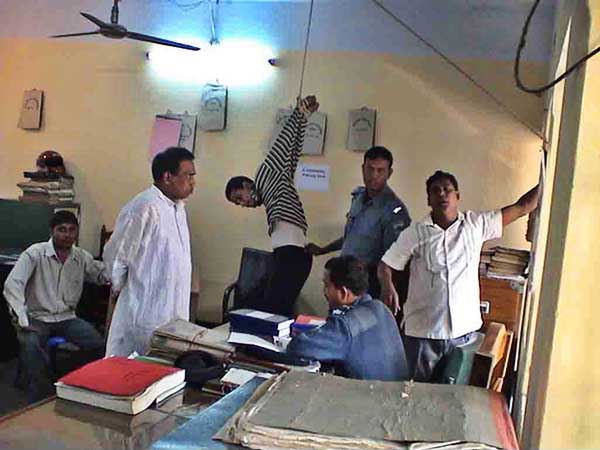
Ratan Kumar, suspected of stealing a gold necklace, was tortured at Bogra Police Station. This photograph (taken with a mobile phone) was published in a daily newspaper, resulted in police officials seen in the picture (the officer-in-charge, three sub-inspectors and a constable) being suspended from active duty. Bogra Bangladesh. 28 January 2007. ? DrikNews

Police fired tear gas shells and rubber bullets to stop agitated students at Dhaka University campus. As protests engulfed the nation, curfew was declared in 6 divisional cities from 8 at night. A student hurls back a tear gas shell. Dhaka Bangladesh. 22 August 2007.? Azizur Rahim Peu/DrikNews
Now is a difficult time. A time for reflection, a time for retrospection, a time for defiance. Sadly for most Bangladeshis, now has always been difficult. Apart from the brief euphoria after independence in ’71, there were the lesser joys when the autocrat left in ’90, on winning a Nobel peace prize in ’06 and even temporary relief when emergency was declared in January ’07. But those feelings have been short-lived. Particularly for the poor. When elephants clash it is the grass that gets hurt.
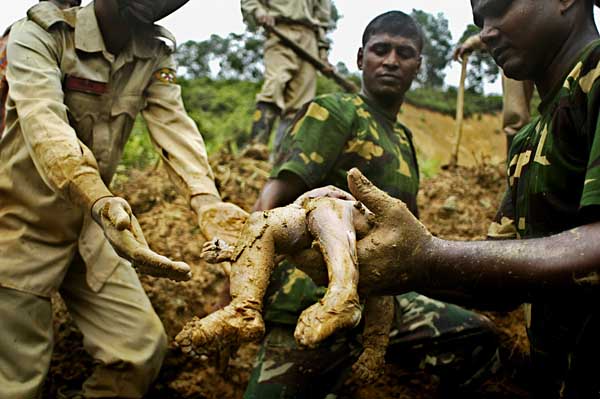
Soldiers and rescue workers recover a child’s body from landslides caused by heavy rains on the deforested hills of Chittagong city. One hundred and six people died, many more were injured. Chittagong Bangladesh. 12 June 2007. ? Tanvir Ahmed/DrikNews
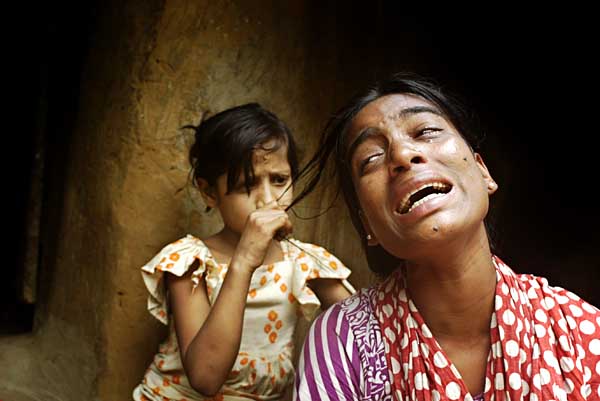
A woman mourns the death of her family members, all of whom died as a result of the mudslide. Chittagong Bangladesh. 12 June 2007. ? Tanvir Ahmed/DrikNews
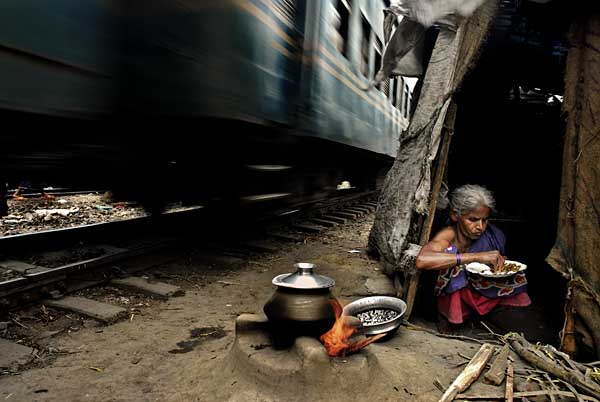
Life is fearful for a slum-dweller. When will she face the next eviction? Dhaka Bangladesh ? Munem Wasif/DrikNews
Arrests in the night, the brutality of high prices and the daily grind of poverty are the realities that wear people down. But they are warriors. Despite the weight of unjust governance, despite the price they always end up paying, they still protest. And the photojournalists? When justice is compromised. When the poor are trampled under the march of ‘reform’. When fear evokes silence. When familiar faces turn away. To stay ‘neutral’ is to stay aloof. They stand on the side of the oppressed. Unashamedly so.
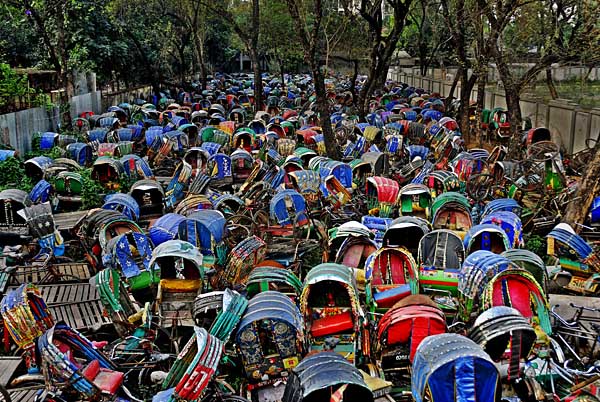
Rickshaws without proper licenses seized by police and dumped near Police Control room. Rickshaws are environment-friendly and affordable by the middle class and often the only source of paid work for men migrating from villages in search of work. 17 February 2007. Dhaka Bangladesh. ? Munem Wasif/DrikNews
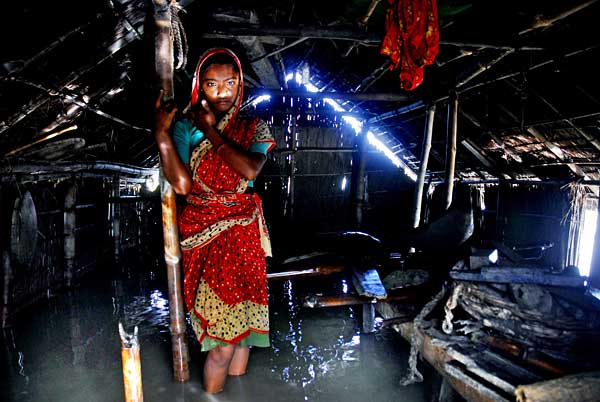
A village woman dries dhan (husked rice grain) as flood waters recede. Chilmari, Rangpur. August 8 2007. A village woman dries dhan (husked rice grain) as flood waters recede. Chilmari, Rangpur. August 8 2007. ? Munem Wasif/DrikNews
On Tuesday the 4th of September 2007 DrikNews will hold its inaugural photographic exhibition “Bangladesh Now”. The photographs shown are a selection from the exhibition.
The exhibition will be opened by Nurul Kabir, editor, New Age, who will share his views about the current situation in Bangladesh,
before the opening. The program starts at 5.00 pm.
Drik will be 18 years old on that day. We’d like you to be with us
The Barren Banana Tree
![]()
Singapore Airlines warned of “protests by university students developing in Dhaka” as we boarded the plane. But emails from Delower and Rahnuma during the brief stopover in Singapore talked of the curfew in place in the six main cities. This was no longer a small skirmish in Dhaka University. Joshim was going to be at the airport with my accreditation card and we would try and find a way back home.

Students at Dhaka University under teargas attack, throwing bricks at police. 22 August 2007. Dhaka Bangladesh ? Munir uz Zaman/DrikNews
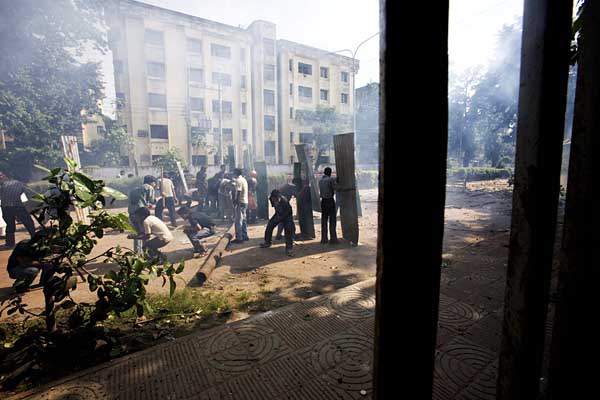
Students at Dhaka University shielding themselves with sheets of tin, during fights with police. Photographer anonymous.
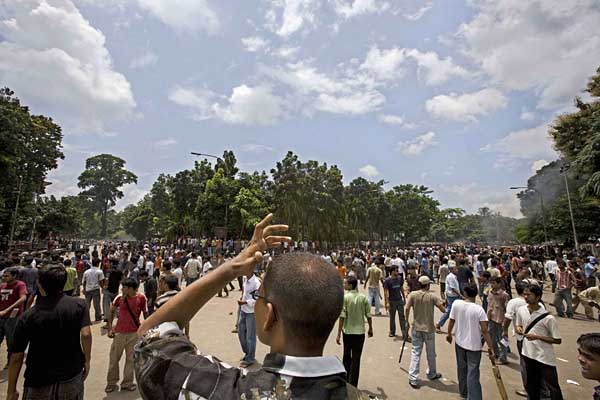
Protesting students gather at Dhaka University campus during violent clashes with police. Photographer anonymous.
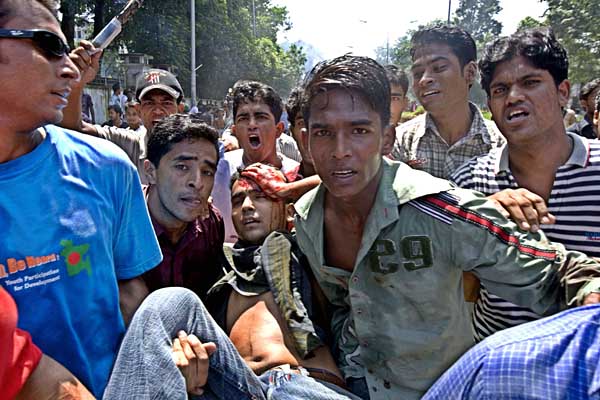
Student hit by police shotgun bullet being carried away by fellow students. Photographer anonymous.
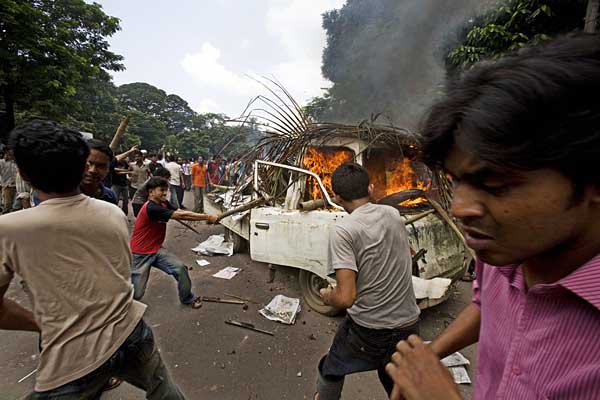
Enraged students burn a car at the Teacher’s Student’s Centre (TSC). Photographer anonymous.
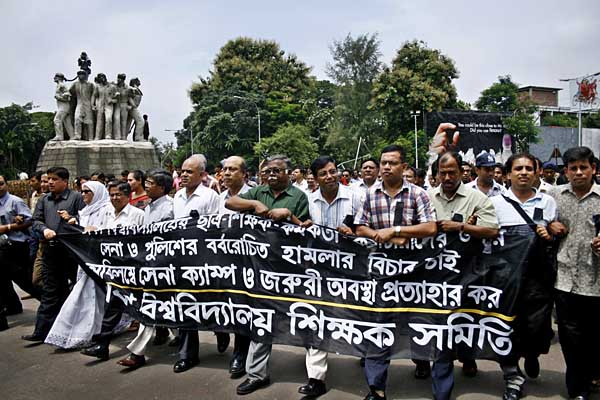
Members of Dhaka University Teacher’s Association protesting against the attacks on campus by police and army, and demanding withdrawal of the state of emergency. Two of the teachers in the front row have since been arrested. 22 August 2007. Dhaka Bangladesh ? Munir uz Zaman/DrikNews
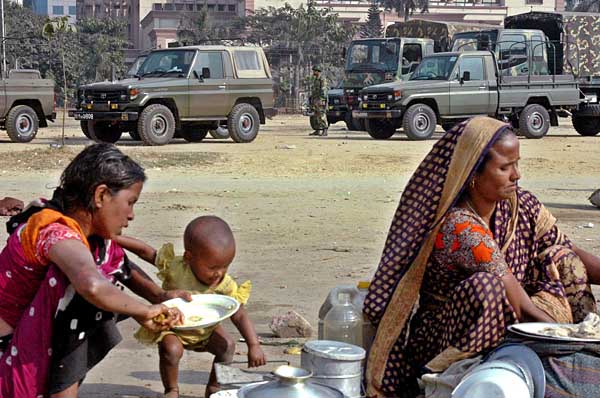
Rocketing prices of essentials create extreme distress for people with low earnings, like the people pictured in the foreground. The military of Bangladesh, which has not had to fight since the birth of the nation in 1971, has in the meanwhile, had increasing budgetary allocations in each successive regime. Numerous allegations about corruption in military purchase, has gone uninvestigated. 22 August 2007. Dhaka Bangladesh ? Munir uz Zaman/DrikNews
The government had taken all mobile networks off the air. With only official press releases for information, the person in the street was in for a rough time. It was easy to find Joshim in the empty car park. Only the occasional long distance truck plied VIP road. I put the video camera on record mode, but relied on my less conspicuous LUMIX to photograph the empty streets. Though I stopped on the Mohakhali flyover to take pictures, I was nervous when the RAB vehicles passed below. There was never a good time for being arrested, but this was as wrong a time as it could get.
Aaasteeey! The policeman strode over lazily. Ki bapar? I did have my card dangling from my neck, and from previous experience, used my confident, ‘I belong here’ approach. That usually worked best with low tier security people.
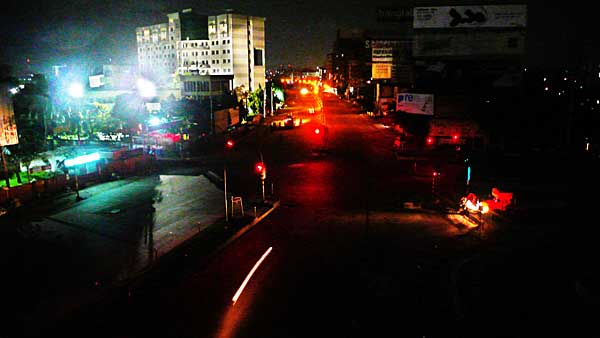
The Mohakhali Junction, one of Dhaka’s busiest traffic spots, is empty on the night of the 22nd August, when the government called an indefinite curfew. Dhaka Bangladesh. ? Shahidul Alam/Drik/MajorityWorld
I’d stopped to take pictures by the near-empty Tejgaon rail station. Stepping carefully through the people sleeping on the floor, I came up to Shahjahan and Neela. Unaware of the curfew, they had brought their sick child Shamim from Tangail, but got stranded in Tejgaon. There was no food, no doctor, no place to sleep, no way of knowing how long this would go on. Each visit to the toilet cost 5 Taka.
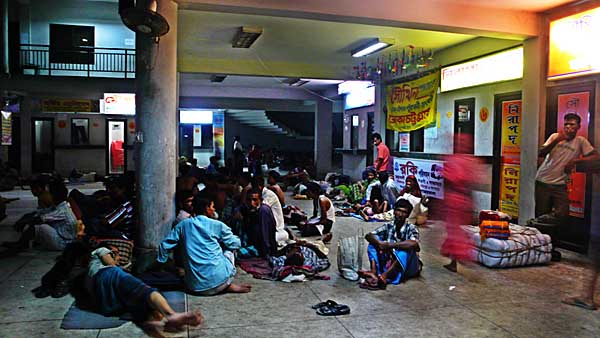
Stranded passengers at Tejgaon Railway Station, sleep on the floor. 22 August 2007. Dhaka Bangladesh. ? Shahidul Alam/Drik/MajorityWorld
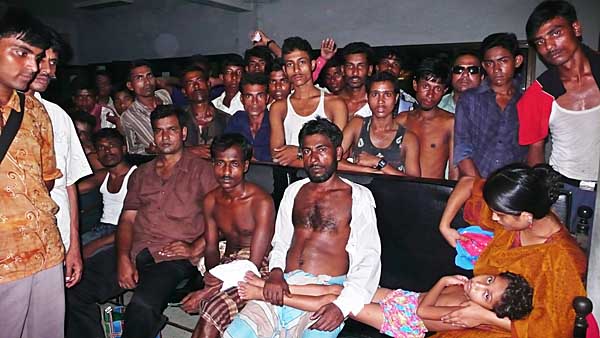
Shahjahan and Neela tend to their sick child Shamim, whom they had brought to Dhaka for treatment. Along with other stranded passengers at Tejgaon Railway Station, the family had no food or drink, or a place to sleep. 22 August 2007. Dhaka Bangladesh. ? Shahidul Alam/Drik/MajorityWorld
The next checkpost was slightly more hostile, but the expired accreditation card dangling from my neck was working overtime. We passed without much harassment. Dropping Joshim home, I went past the Shonar Bangla Market in Karwan Bazaar. The busy market place had a haunted look. No cackle of chickens, haggling for prices, or calls from vendors. Just one man counting loose change.
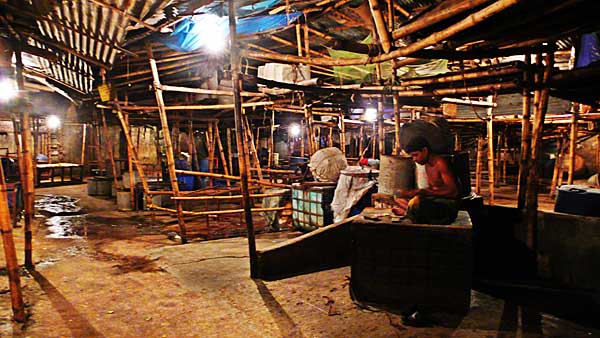
Shonar Bangla Market at Karwan Bazaar is one of the busiest market places in Dhaka. The shops are empty on the night of 22nd August 2007. Dhaka Bangladesh. ? Shahidul Alam/Drik/MajorityWorld
The brightly lit Square Hospital in Panthapath stood out in the dark. Government orders to turn down the lights after dusk to save electricity was presumably for commoners only. The street was empty, but this time as I approached with my camera police converged from all directions. I fumbled a bit, but recovered in time to get one shot. This was not the time to look for best angles. Rattling off important sounding words like ministry of information, and dropping the occasional names I could think of, I got into the car and drove off before the uniformed men had gathered their wits. A government adviser’s business interests in Square Pharmaceuticals – while undeclared – was well known. Students had already attacked the building the previous day. The approaching police knew whose business interests to protect.
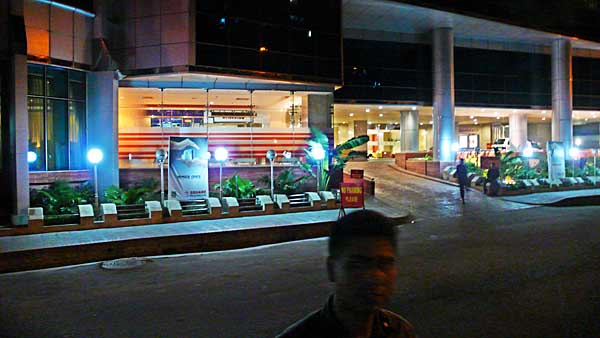
The Square Group, one of the wealthiest business enterprises in Bangladesh owns the Square Hospital. Government regulations prohibit the excess use of electricity and non-essential shops are required to close by 8 pm. Several people were killed by the police when they came out in protest, demanding adequate electricity. The Square Group is owned by the family of one of the advisers of the caretaker government. 22 August 2007. Dhaka Bangladesh. ? Shahidul Alam/Drik/MajorityWorld
The road through Dhanmondi was eerie. The women who walked the streets near Abahani playground were nowhere to be seen. Like the many others who struggled to make a living, they too would not be earning tonight.
The junction near ULAB was scarred by burnt tyres. The convoy of police vans deterred me from getting my camera out and I turned into road 4A. It was time to go home. Kamaler Ma, Joigun, Zohra and Rahnuma were all up waiting. With the mobile network off, they didn’t have any news about me. There must have been others in many more homes who were up worrying.
Rahnuma and I talked of the events over the last two days, of the army camp in Dhaka University. Of a soldier slapping a student. Of the vice chancellor (acting) being beaten up by police. This had never happened before, not even during the Ayub or Ershad military regimes. The reference to ‘evil doers’ in the chief adviser’s speech to the nation was worryingly close to the ‘axis of evil’. Independent media channels were then still defiant. That night the information adviser advised the media to practice ‘self censorship’.
Despite their claims, this government had never been called in by the people. We had no say in who the advisers would be. It was not military rule the people had welcomed, but the cessation of violence and the fear of further anarchy if the rigged elections were held. Banana trees would have made equally good replacements. However, banana trees would not have sold national interests. Closed down environmentally-friendly jute mills. Made slum dwellers homeless, or tortured and killed adibashis protesting the military acquisition of their ancestral lands. So while there was initial relief, as the price of essentials soared, news of nepotism and the partisan manner in which Jamaat -e-Islami was being shielded soon made people realise this banana tree would never bear fruit, let alone run a government.
Warrantless arrests by plainsclothes army under the cover of curfew. Dissenting teachers picked up in the middle of the night. Making threats to independent channels ETV and CSB are hardly the character of a saviour government pledged to the return of democracy. As the behind-the-scene military decides it will now take centre stage. As Bangladeshis realise that a democratically elected autocratic government has simply been replaced by an unelected autocratic one, the tune in the streets is changing.
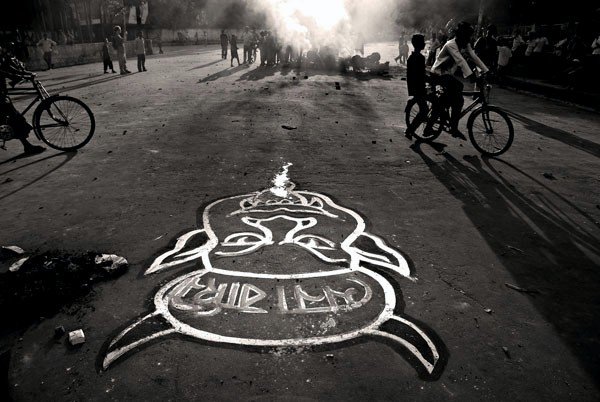
Symbols of fascist oppression drawn on university road. 21st August 2007. Dhaka Bangladesh ? Munem Wasif/DrikNews
Multiple demands of students and teachers have been whittled down to one – withdraw emergency rule. Underground pamphlets are spreading like wildfire. With the Internet down, text messages are filling up the ether. The information adviser’s suave statements to the media faltered as he snapped, “why such a fuss about a slap or two?”
****
The photograph that was being shown here has been removed on the request of the photographer
****
“In unprecedented scenes, soldiers in uniform were seen being chased out of the Dhaka university campus by students. In two days, the myth of the army’s omnipotence was all but laid to rest.” BBC. Photographer Anonymous.
The US has declared support for the chief adviser’s statement. What he lacks is the support of the people.
When the Waters Came
![]()
It was nearly twenty years ago when I had written this. After one of my first photojournalistic assignments:
What does one photograph to depict a flood? A submerged house, a boat on a highway, people wading in water?
As we boated through the branches in Jinjira we found a wicker basket in a tree. The family had long since abandoned their home, and their worldly belongings, gathered in that basket, waited patiently for their homecoming.

Wicker basket in tree. Jinjira. 2nd September 1988. Dhaka Bangladesh. ? Shahidul Alam/Drik/MajorityWorld
The worst flood in a hundred years? That statistic is hardly relevant. They, as those before them and after them will always face the floods. How does it matter whether they are 60% starved or 75% starved? How does it matter what country the relief wheat comes from? They themselves are mere statistics to power hungry politicians.

The family still needed to be fed. When I went back the next day to this place in Jinjira, the water had risen another three feet. I never saw her again. 2nd September 1988. Dhaka Bangladesh. ? Shahidul Alam/Drik/MajorityWorld
What is relevant are the feelings that have been kindled, that half kilogram of rice that has been shared, that solitary dry house that has warmly welcomed all who have needed the shelter. That others have shared the pain.
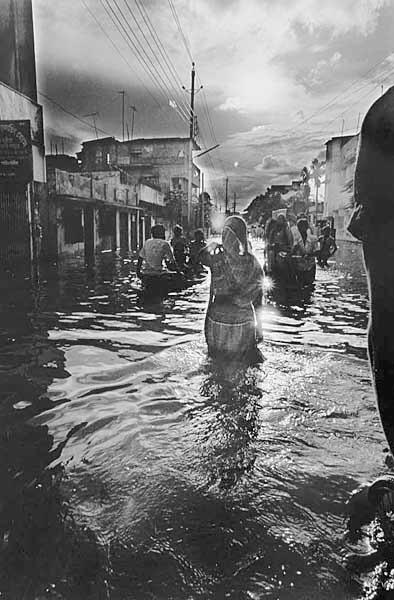
Wading down a street near Kamlapur railway station. “Dreamland Photographers”, the local studio, was still open for business. 2nd September 1988. Dhaka Bangladesh. ? Shahidul Alam/Drik/MajorityWorld
What is relevant is that now the roads are dry and the walls repainted and that a nation that once so cared has so quickly forgotten.
I look back and merely feel the ineffectuality of my images.
Shahidul Alam
Dhaka 1988
Nearly twenty years on, the floods are with us again. They are a part of our natural agricultural cycle. They irrigate the land, replenish the topsoil, remove the toxins. But deforestation in the mountains, illegal constructions, ill planned roads and ill caring leaders make floods take on a violent form. The waters get angry.
This year, when the waters had risen, our adviser advised that it was not yet a calamity. When the waters reached danger levels, the decree came that because of the state of emergency, ‘[political] banners were banned’ so while people struggled for food and shelter, banner rights became the issue. Now as the waters engulf the land and people flounder in need of relief, our adviser advises us ?we don?t have to help the people, they?re going to their relative?s house by themselves?.
Now that is a solution Bangladesh can offer to all the distressed people in the world. Just go find a relative.
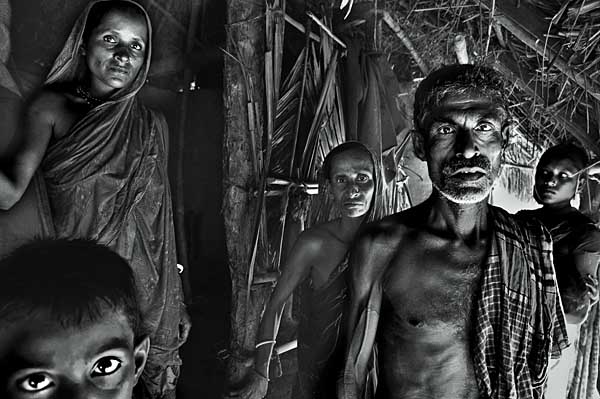
Before the floods. People affected by cyclone Akash. Mohishshoiri River. Khulna. 21 May 2007. ? Tanvir Ahmed/DrikNews
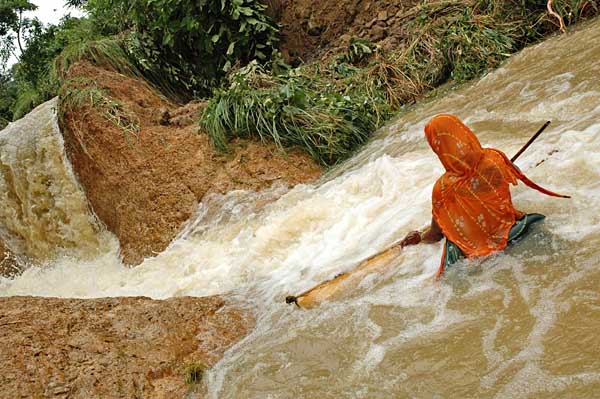
Woman fishes in the flood waters. 13 June 2007. Comilla Bangladesh. Kalim Shantu/DrikNews
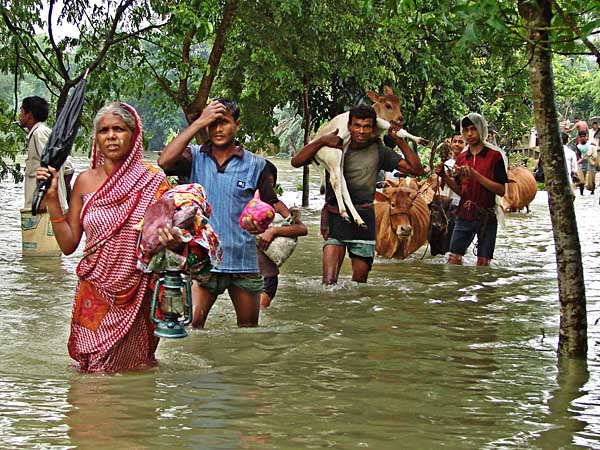
Twenty villages had been affected at the junction of the rivers Ghagot, Brahmaputra and Teesta making numerous people homeless. 31 July 2007. Gaibandha. Bangladesh ? Quddus Alam/DrikNews
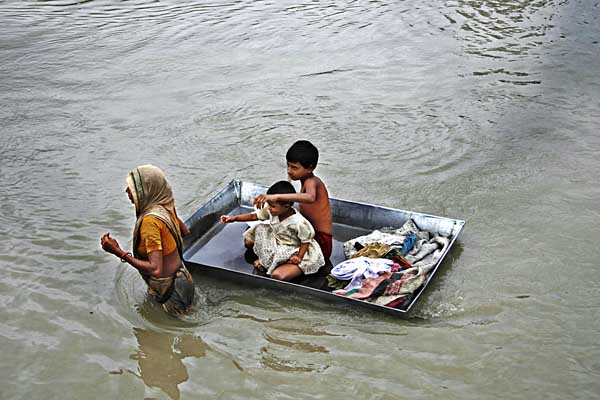
Woman in search of dry land. 30 July 2007. Sirajgonj Bangladesh ? Tanvir Ahmed/DrikNews
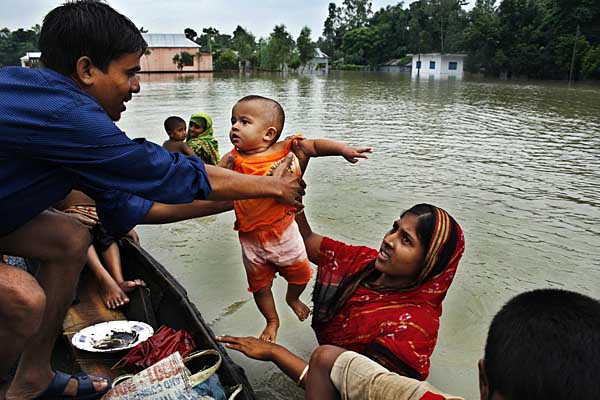
Villagers rescuing mother and child. 30 July 2007. Sirajgonj Bangladesh ? Tanvir Ahmed/DrikNews
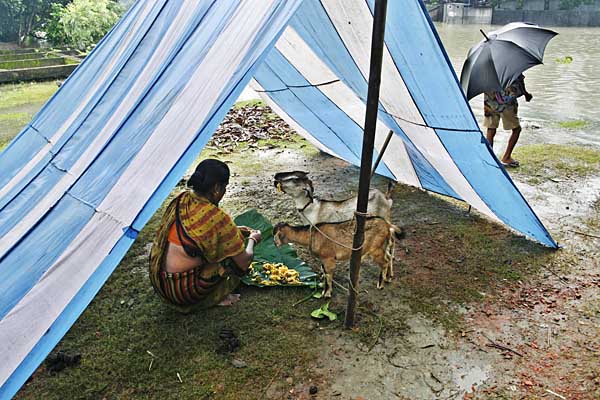
Woman feeding goats in makeshift tent. 30 July 2007. Sirajgonj Bangladesh ? Tanvir Ahmed/DrikNews
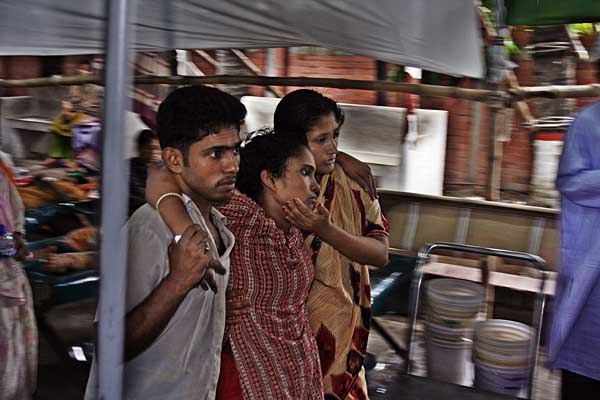
Diarrheal patients at hospital in Dhaka. 11 August 2007. Dhaka Bangladesh ? Munir uz Zaman/DrikNews
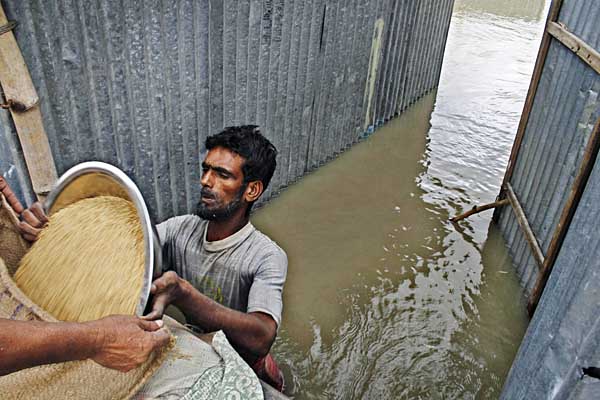
Spontaneous relief operations organised by citizen groups. 30 July 2007. Sirajgonj Bangladesh ? Tanvir Ahmed/DrikNews
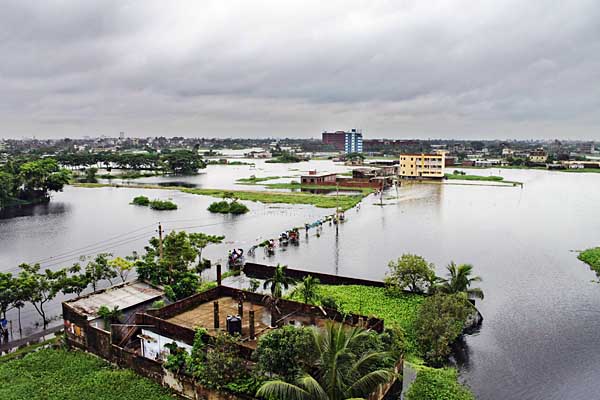
While one third of the country was flooded, people inside the DND (Dhaka Narayanganj Demra) embankment faced the stagnant water cause by rains. 25 July. Narayanganj Bangladesh ? Tanvir Ahmed/DrikNews
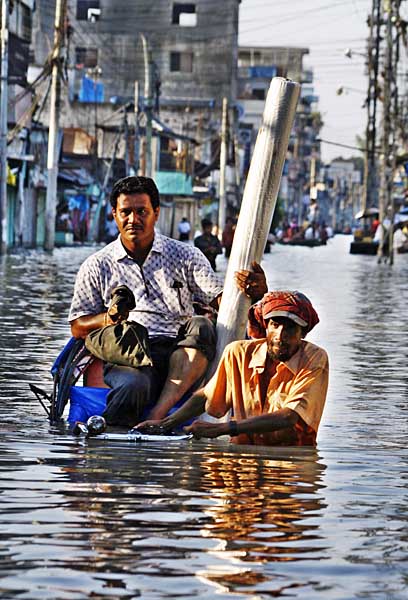
700,000 people were marooned in Sirajgonj. 64 people had already died when this photograph was taken. 5 August 2007. Sirajgonj Bangladesh ? Tanvir Ahmed/DrikNews
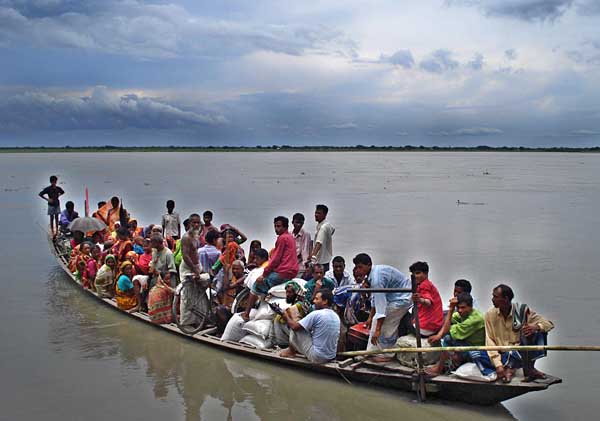
Boats are the only means of communication during floods. July 2 2007. Rangpur, Bangladesh. ? Ador Rahman/DrikNews
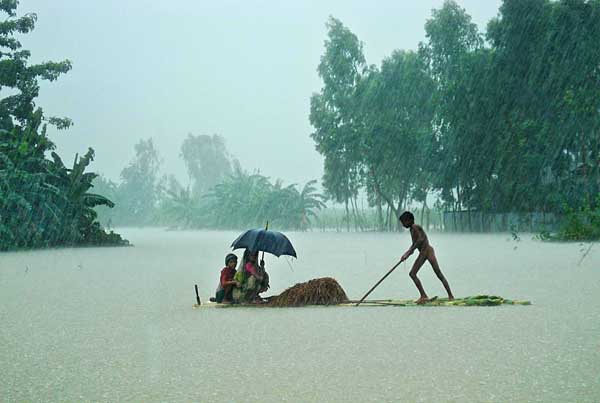
A family looks for shelter using a raft made of banana trees. 31 July 2007. Gaibandha Bangladesh ? Quddus Alam/DrikNews
And across the border, viewed from afar:
The Rains Reach Kolkata
When I was just a little boy, I watched the clouds advance
From rooftop high above the streets and bustle of Calcutta.
Up there, I watched the hawks soar high, and saw the palm fronds’ dance,
In wind that blew before the storm, and banged each window shutter.
It was in June, when summer’s heat had risen to its height,
That clouds approached, as though for war, advancing in a line,
Their heads held high, dark wall beneath — a fear-instilling sight,
With lightning streaks, and thunder-growls of warriors divine.
The sparrows, crows and pigeons fled, in haste to get away
And find refuge, as dust was blown from streets by gusts so strong
That palm trees bent, and tossed their heads, and back and forth did sway,
As leaves and clothes, and sailing fronds, with birds were swept along.
Then from the heat, we knew respite, as cool winds did descend
>From belly of the thunderhead, which bore a mist so fine,
With ions, whose electric charge did minds and bodies mend
And lift from summer somnolence like clear celestial wine.
And I would run and scramble down, from perch on highest roof,
To shelter in a doorway, where I still could watch the storm
Without myself being blown away, or struck by lightning hoof,
As racing clouds obscured the sky, like wraiths in equine form.
And then the dark, the greenish gloom, the flash more bright than sun,
The crack so loud it seemed the earth was cloven by the sky,
And pelting rain in slanting sheets, like bullets from a gun,
On roofs of tin, and wooden shades, and roll of thunder high!
And so the chariots of the gods would roll by overhead,
And we could hear the neighs and roars, and see the sparks that flew
As titans battled in the skies, by trumpet blowers led,
And sword of land pierced mail of sea, and blood of rain then drew.
And all the kids would venture out, unheeding of the scolds,
To jump with glee and leap and splash, in dance as old as time,
And yet as freshly bold that day, as in the eons old,
When sea would come to land to fight, and mate, in yearly rhyme.
Babui / Arjun Janah*
2007 August 11th, Sat.
Berkeley, California
*Arjun has an identity of his own, but for us photographers, he is the son of the legendary Indian photographer Sunil Janah.
The Last Goodbye
She would put on a burkha every morning so that choto chacha, my dad?s younger brother, could drop her off at her parents. He would take her to her college instead. That was how Quazi Anwara Monsur graduated. Dadi didn?t want her daughter-in-law to be getting an education, but Amma had the full support of Abba, my father. Her in-laws probably knew what was going on, but as long as Dadi?s authority was not directly challenged, Amma was quietly allowed to complete her studies.
Amma had made a mark upon her arrival from Kolkata to her in-laws in Faridpur. Word had gotten round that Monsur?s wife knew how to shoot a gun. She had many other skills too, and being a school teacher was also able to support the family. When Phupuabba (my father?s brother-in-law) died, the orphans were split up. Bhaijan and Rubi Bu came to live with us. Only my sister had been born then, and overnight a one child family became a three child family. They were difficult times. The family had come over to flee the riots in Kolkata and my father?s low paid government salary was simply not enough. Particularly as Abba and Amma insisted that all the children should have a good education. Amma?s teaching job, plus the extra income she made from marking exam papers wasn?t enough to keep the family going. She would buy wool from the market and knit sweaters to sell for extra income. Later Khaled Bhai was born and no other children were planned. In Amma?s words, I was an ?accident.? Dadi, who had always been against her daughters-in-law going to work, saw the value of what Amma was doing and later it was Amma she used as an example to encourage her other daughters-in-law to get jobs.
Mera Sunder Sapna, the song Amma loved to sing
Once they moved to Dhaka, Amma wanted to setup a school in Azimpur colony. No one was supportive, but that never stopped her. Buying a tent from Rafique Bhai for ten taka, she pitched it in the middle of Azimpur playground and set up Azimpur Kindergarten. Later, in its new name of Agrani Balika Biddalaya, the school and the college went on to become one of the finest educational institutions for girls in the country.
New classrooms grew alongside the tent. There was a large classroom ?The Pavilion? which even had brick walls. When a storm in sixties blew away the bamboo classrooms, Amma sat crying in the mud floor that remained. A guardian saw her from the veranda of their house and came over to comfort her. ?Do you think it is only your school? he had said. ?It belongs to all of us, and we?ll rebuild it.? They did. The guardians and the teachers and the children had organized cultural shows and other fund raisers. This time they were determined there were to be no more bamboo walls. Each classroom had a tin roof but the walls were made of bricks.
Many years later, Amma felt she needed qualifications in psychology to run her school better. She managed to get herself a scholarship to go to Indiana University, and eventually got herself a PhD in child psychology. That was the nature of the woman. Less than five feet tall, once this diminutive woman had decided on something, there was little that could stop her. This did not always make it easy on her children. Her standards were high, and those who failed to meet them, or like my brother Khaled, who felt there were other things to life, felt the brunt of her wrath. The dedicated teacher was not always the compassionate mother. Her public contributions won her the Rokeya Padak, a state award, but with the death of her son Amma paid a terrible price. The night before he took his life Khaled Bhai told me, ?I am making things easier for you.? I had not understood the implications then. I was 14, he had just turned 21. It was a price we all paid.
His death had mellowed Amma, and I got away with much that my brother would have been chastised for. Having lost one son, she became hugely protective of the other. After the 1971 war, Amma and I went over to Kolkata to smuggle my sister and her family out of the country. It was my first taste of India and Amma and I used the opportunity well. Kolkata was the cultural capital of India and we would see three films a day, and the occasional play.On our return to a free but unsettled Bangladesh, we found things were dangerous, and there were no set rules. Once, when I needed to negotiate with some hijackers who had stolen our car, this tiny woman insisted she would stay with me and be my bodyguard.
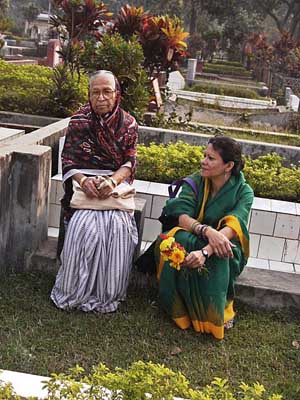 Amma and Rahnuma by Khaled Bhai’s grave
Amma and Rahnuma by Khaled Bhai’s grave
Her protectiveness had its own problems, and as an adult, when I rejected her choice of a homely bride and found a partner of my own, she did all in her power to break up our love. Rahnuma and I stuck together despite it. Though Amma later relented, our relationship had been severely tested, and came precariously close to breaking point. Amma was strong and feisty, and didn?t take being challenged too lightly. Plucky, headstrong, and hugely energetic, she nurtured whatever she loved with a passion. Till she was 80, she would go to college everyday, ensuring that it ran smoothly.
I had gone to UCLA for the Regents Lecture. It was in LA that I got Rahnuma?s message that Amma had been taken to hospital. Apamoni, the ever dutiful daughter, now a retired doctor in London, had rushed to Dhaka to nurse her. She told me that things were stable, and I needn?t hurry back. I went on to Florence where I was conducting a seminar. Rahnuma?s second message said Amma was slipping. It was a very long flight back. My nieces Mowli and Sofia got a last minute Emirates flight and we met up in Dubai. An hour?s delay at the airport, the delay at the luggage belt on reaching home and the rush hour traffic became unbearable as we wondered whether we would see her alive. Amma wasn?t going to give up that easily. She wanted us around, and her face glowed as she saw the three of us. Fariha, my youngest niece, arrived the next day.
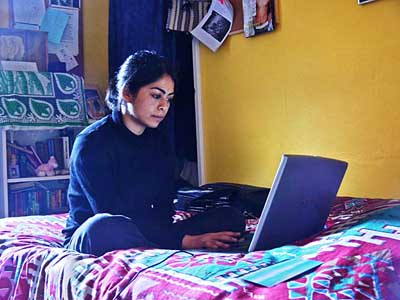 Fariha
Fariha
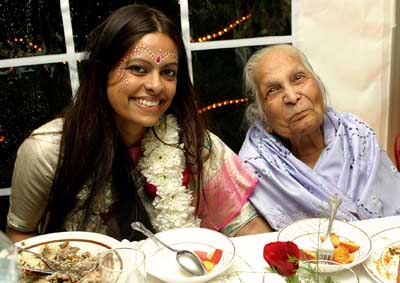 Amma at Sofia’s wedding
Amma at Sofia’s wedding
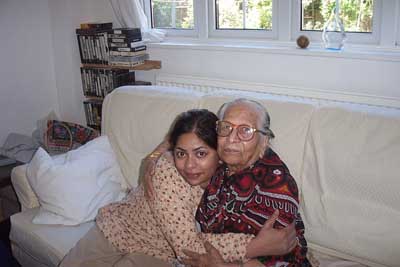 Amma and Mowli
Amma and Mowli
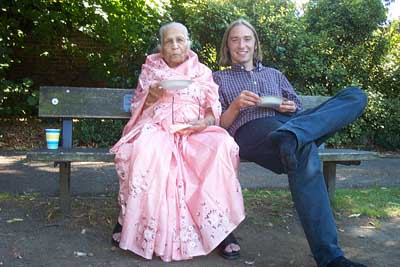 Amma and Sofia’s husband David
Amma and Sofia’s husband David
My nieces got out the family album, and through the pain, she peered through the photographs. As she looked at a picture of me, Fariha asked ?Who are you looking at?? The face broke into a smile. Frail, but distinctly a smile. It is wonderful how the tiniest of movements transforms a face. She whispered my nickname ?Zahed?. Later as she strained to lift her hand to stroke me, Fariha joked, ?Grandma, pull his beard.? Another smile and a whisper, ?Beard?? Later when she stroked me again, Fariha repeated her joke. Another impish smile and the word ?Pull?? Those were the last three words she ever spoke.
Apamoni had toiled ceaselessly to take care of her. Rahnuma had run ragged with errands, her grandaughters stayed up all night giving her water, changing her clothes, checking the oxygen pressure, coaxing her to eat and put on the nebuliser. Hameeda and Zohra both knew Amma well. They bathed her, combed her hair and nursed her, trying to interpret every gesture. Delower, whom Amma saw as a son, was omnipresent and kept the ship from sinking. Dulabhai, my brother-in-law, also a retired doctor, kept vigil from afar. But it was me that she longed for. This was not the time to dwell on patriarchal politics. I was losing a person who loved me beyond reason. With all my traveling, I had always wondered where I might be, when the time came. I needn?t have worried. Amma waited till I returned.
After many rainy days, with Chittagong in a deluge, the sun shone through this morning. Amma didn?t like 13. Saturdays were bad. Thursday was the best day of the week. At 8 this morning, Thursday, the 14th June, carefully sidestepping a 13 and a Saturday, with the sun glistening on her favourite champa tree, Amma chose to say goodbye.
She was 83. In those last few days, I saw my mother in a way I hadn?t before. I knew the softness of her skin, every little mark on her face, the shape of her tiny feet, the wrinkles on her fingers. As I carried her to the wheelchair, or moved her up the bed, I felt her weight against my body. I knew how it felt to be lovingly stroked by a hand that had barely the strength to move.
Her janaja was at the Takwa Masjid in Dhanmondi. My colleagues at Drik and Pathshala, our Out of Focus children did all that was needed. They would have borne my grief if they could. Many years ago, I had stood in the same mosque during Abba?s janaja, on an Eid day. We then went to her school. As the long line of students, teachers and well wishers from all over Azimpur walked past to take one last look at their beloved Boro Apa (big sister), I walked across to the classroom where I had studied. Through my tears, the benches and tables looked tiny now. Sitting on the bench and looking up at the blackboard I could hear Boro Apa?s footsteps on the corridor.
The grave in the New Azimpur Graveyard, had been bought in 1970, when Khaled Bhai had died. We had then bought three plots, for Amma, Abba and Khaled Bhai. The plot in the centre had been empty. I lowered Amma into the grave. She herself had bought the shroud and had it washed with Aab e Zam Zam, the holy water from Mecca, in preparation for this moment. The white shroud glistened against the dark clay. Our relatives and friends, Ammas students spanning sixty odd years, my own students and Amma?s numerous admirers were there. They carried the wooden Khatia, lit the incense, scattered rose water. They shared our loss.
I remembered the finality of the knot at the ends that I myself had tied. Neat rows of bamboo stakes were placed diagonally across the grave, shielding her body from the earth that was going to cover her. Bamboo mats were folded over the stakes that sealed her in. Then we all took turns to cover her with earth. After the munajat (prayers), as I walked away, I imagined my mother in between her husband and her elder son, reunited in death. I could hear them calling out to me ever so lovingly. ?Zahed?.
Dhanmondi, Dhaka
14th June 2007.
National Geographic Honourable Mention
![]()
Munem Wasif’s photo essay “Belongings” receives Honorary Mention at National Geographic All Roads.
source: 1st June 2007
Chris Rainier & Eduardo Abreu
All Roads Photography Program
http://nationalgeographic.com/allroads
Interview on Uprising Radio:
http://uprisingradio.org/home/?p=1577
The Price of Peace
![]()
I am the rage I am the storm
My path I leave barren and shorn
Swaying in my crazy dance
I rejoice at all I face
Move at my own pace
I grapple my foe
I wrestle to die
I am the warrior, head held high*
He was a dreamer, a rebel, a lover, a poet. He moved strong men to tears and woke a nation to unite against tyranny. The British imprisoned him only to find his pen spewing venom from the prison cell. Yet, Kazi Nazrul Islam was a romantic, and his lilting songs, magical stories and even his fiery verse did more to bring together Muslims and Hindus than any peacemaker had ever done. The poor turned away from God?s door, the lover spurned, the weak, the meek, the downtrodden, all found refuge in his words and his music. Unlike the literary giant of the time – Tagore, Nazrul was uncompromising. He spoke of strife, and the peace of acquiescence was never his mettle. Mixing Persian, English and Hindi with his majestic repertoire in his native language Bangla, Nazrul called a nation to war against its occupiers, but also spoke out against the tyranny of religion and class. It was his haunting love songs however, that made Nazrul inimitable. Living the life he preached, he refused to conform. Marrying outside religion, shunning material comfort, and eventually rejecting our carefully defined sanity, he rebelled against a peace that required the acceptance of the status quo. Conflict was his muse.
Lalon, long before him, had traversed a very different terrain. The journey between the body and the soul. The metaphors of the bird and the cage, with the soul flirting with the body, elusive. tantalizing and ever so ephemeral. The sufi saint dealt with the conflict between the material world and the spiritual realm. But for Bangladeshis it wasn?t Tagore or Lalon or even Nazrul, but the struggle for language itself that galvanized the nation. Separated from India on the basis of religion when the British were forced to leave, East Pakistanis had always felt exploited by the West wing and discontent had been brewing, but it was when Jinnah declared that Urdu would be the national language of Pakistan that people took to the streets. The violent birth of Bangladesh, gave a nation with its own language, but Bangali nationalism too became the oppressor of other cultures and the indigenous people of the Hill Tracts have been brutally reminded ever since that they are the other. Their peace could only be earned at the cost of their identity.
Surendra Lal Dewan, was sad that his song had been stolen by the president, but that was not what pained him most. As director of the Tribal Centre in Rangamati, he was required to bring out Pahari women dressed in ethnic garb at regular intervals. They would dance in bright tribal costumes for tourists, visiting dignitaries and even curious Bangalis whenever the state needed to demonstrate Bangladesh?s tolerance and its ethnic diversity. In his song Dewan had spoken of a Bangladesh free of oppression and torture. That a military general, claiming the song to be his own, would use the same words to chant of an egalitarian Bangladesh pierced Surendra with his own words.
Even the naked halogen lamp that shone on the creaky planks that made up the stage near Ispahani Gate 1 had gone. It was the port town of Chittagong and there was no electricity. It didn?t affect Mustafa Kamal and the UTSA theatre group. A string of candles lit up the actors. The children came up close. Kamal wasn?t involved in national issues. He and his group performed to children and their parents, in the slums around Gate 1, and in many other parts of the country. The plays would talk of HIV/AIDS, dowry and land rights. The team would go out to villages and settle land disputes, or fights over someone?s loss of face, by getting the villagers to enact their strife in public. Their participatory plays used humour, love and the occasional risqu? dialogue to enthrall a rapt audience who found a momentary outlet from their tortured lives. But the plays were not simply about temporary relief. They introduced strategies for dealing with the tensions that built up between the landed and the landless, between the buyer and the seller, but also between friends, relatives and neighours. Kamal understood that conflict was a natural product of relationships. While controversies and grievances resulting from differences in values, competition for resources, or perceived threats, often result in conflict, its mitigation rarely depends entirely upon the solution of the problem, but might only require a release through rituals of protest.
Artificial barriers between nations, illegal occupation of lands, the struggle between the worker and the employer, the exploitation of women and children, and the suppression of minorities generate sparks that might set ablaze communities, and the fires needed to be doused. But there was more to art than being the key to the cage. Kamal worried that while his art might allay the tension, it might, through appeasement – like the empty rhetoric of politicians, like the opium fed to the hungry child, like the comfort assured in afterlife, like the promises of peace by generals – help perpetuate the greater wrong.
Shahidul Alam
Los Angeles
24th May 2007
* Translated and adapted from the poem ?The Rebel? by Kazi Nazrul Islam
Abridged from an essay written for the Prince Claus Fund for the 2007 Award Book on the theme ?Culture and Conflict?.
Kazi Nazrul Islam (b. May 25, 1899 ? d. August 29, 1976 ) was a Bengali poet, musician, revolutionary and philosopher who is best known for pioneering works of Bengali poetry. He is popularly known as the Bidrohi Kobi ? Rebel Poet ? as many of his works showcase an intense rebellion against oppression of humans through slavery, hatred and tradition. He is officially recognised as the national poet of Bangladesh and commemorated in India.
The birth date of Kazi Nazrul Islam, originally recorded on the basis of the Bangla calendar, is considered by some to be the 24th May 1899.
The Trojan Horse
Standing in the grand parliament building in Karachi, built by his grandfather, veteran Pakistani MP Qamar Zaman reflected on the irony of it all. He had long campaigned against the militarization in Pakistan, but recent developments in Bangladesh worried Zaman. ?They saw what went wrong in the Pakistani experiment and decided to fine tune it? he lamented. The election commissioner in India, SY Quraishi, repeated the sentiment. Bangladesh following in Pakistan?s footsteps was not something he welcomed. Kunda Dixit, in Kathmandu, talked of how the same blueprint was being used in all our countries. Despite the rhetoric of democracy, the militarization of South Asian countries was the flavour of the day. Aided by chaotic situations created by political mismanagement, the anti-corruption Trojan Horse brought in its deadly military content.
As in Troy, the people had welcomed them with open arms. Years of mismanagement and corruption had worn down their patience. People wanted respite, regardless of where it came from. This was just the window the military needed. Not wanting to lose out on the lucrative UN placements, they needed a mask. The ?neutral? caretaker government was the perfect foil. The arrests of corrupt politicians, businesspeople and godfathers provided a much needed relief. Few worried about the flimsy, and sometimes concocted accusations used to reel them in. None dared to speak of the glaring omissions. Curbing media freedom took care of the main obstacle. The military or the Jamaat were strangely absent from the list. Amongst the largest and most controversial deals made during previous regimes were the MIG and the Frigate purchases. Yet neither had featured in the cases being investigated. ?kaker mangsho kak khai na.? (A crow doesn?t eat crow?s meat).
After much foot dragging, and over two months of delay, a one member body was asked to probe into the death of adivasi activist Choles Ritchil in the most gruesome killing while in military custody. The Shadarghat launch disaster, in contrast, had three separate investigation committees ordered to submit reports within 24 hours. Choles on the other hand had resisted a multimillion dollar deal to take over adivasi land. It was a different ball game.
Tasneem Khalil was one voice that they had not been able to silence. His incisive, well researched investigations flew against the culture of silence that prevailed. Mahfuz Anam, the editor of the leading English daily, The Daily Star, had proudly told me, ?In all these years, not a single story had been spiked.? That was some time ago. Things were different now. The story of military involvement that Tasneem had revealed was pulled back from the press in the last minute. A commentator on the roundtable at Drik on the 3rd May, International Press Freedom Day, had equated the Daily Star and the Daily Prothom Alo with a new political party. The newspapers had elaborate reporting on the US ambassador’s love for democracy and a free press. The Drik roundtable, featuring some of the bravest journalists working in the land, went unreported. The roundtable had discussed the military, the corporate deals taking place, the heavy hand of foreign countries. It talked of deals being pushed through in the absence of dissent. Tasneem had deliberately not been asked to speak. That would be inviting trouble.
That didn?t protect Tasneem for long. In my room in Shangri La Hotel in the early hours of this morning I received an SMS from a student. Tasneem had been picked up from his home. This is a risk that all journalists speaking against the?government are prepared to take, but given what Choles Ritchil went through, this arrest is more ominous. A suicide note for an epitaph is too likely an outcome to let the system take its course.
Shahidul Alam
Kathmandu
11th May 2007
From SAJA list:
Daily Star reporter (formerly with New Age), and CNN Dhaka stringer, Tasneem Khalil was
picked up by men in plain clothes @ midnight, claiming to be from
“Joint Forces”/Army.
Tasneem Khalil Picked Up By “Joint Forces”
CNN Reporter Picked Up
Tasneem’s Blog
Tasneem, We’ll Come Get You
http://salamdhaka.blogspot.com/
Human Rights Watch Issues Alert
Tasneem on Choles Ritchil Case
Tasneem on Modhupur
Tasneem quoted in Washington Post
Sabash Bangladesh!

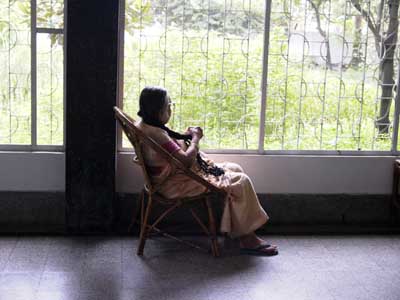
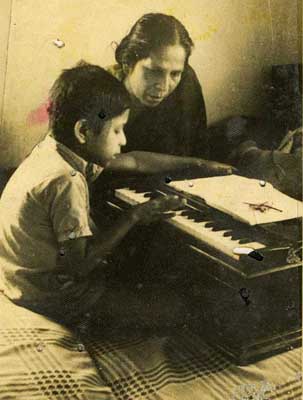
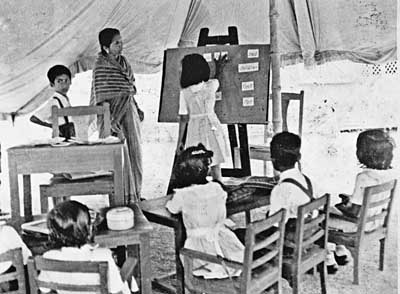
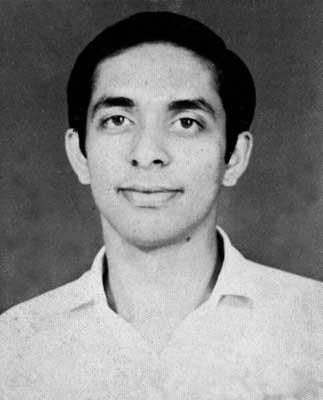
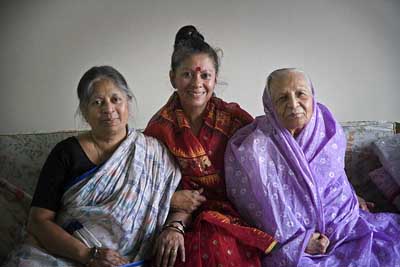
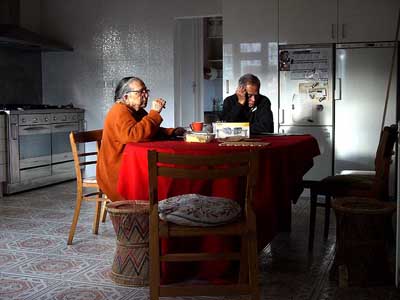 Amma and Dulabhai
Amma and Dulabhai